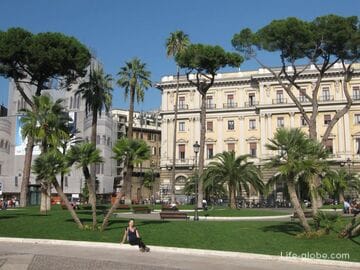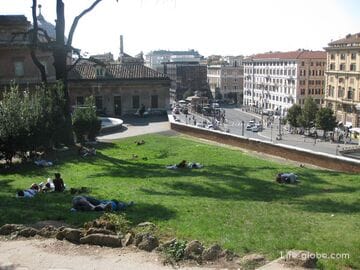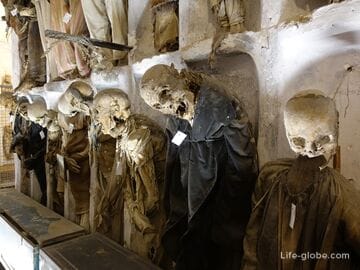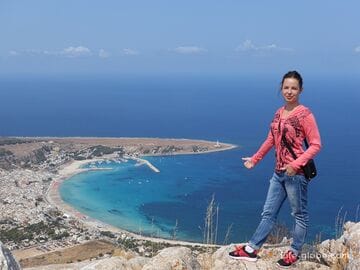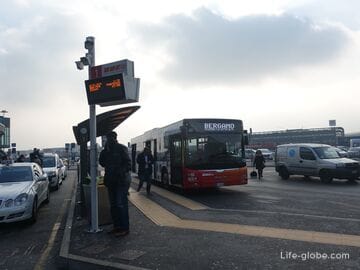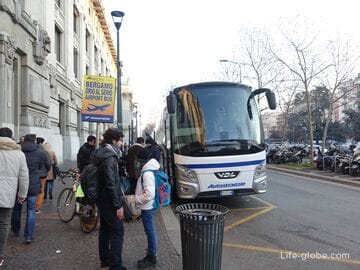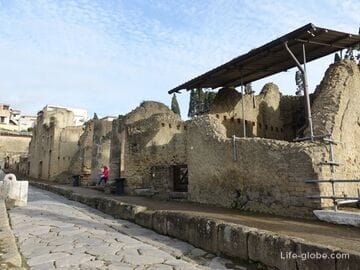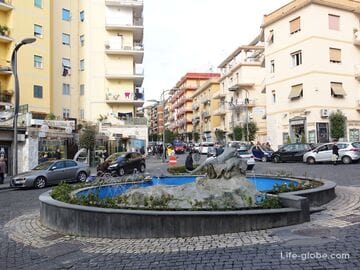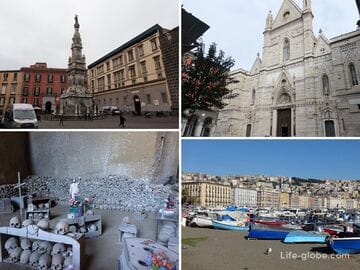Rome is a unique city that holds a special place among European capitals. In the historical center of Rome a great many monuments of history and architecture, which attract many tourists from all over the world.
Rome is the special atmosphere of unprecedented power and history. Everything in Rome is saturated with the spirit of past centuries. In the city there is a kind of atmosphere, and even smell in Rome on your own - unique and unique. Here the winding streets, churches and palaces, architectural dominant and the amazing beauty of the area, ancient ruins and monuments.
In the historic centre of Rome, any new building or Church that neither the square or the fountain, the landmark. Walking around the city, and then find the interesting places that can pull any article. However, among all this variety, you can still isolate a few dozen of the best of the best, most of the.
In this article will tell you about the Top 23 most popular and, in our opinion, the most interesting sights of the historic centre of the Italian capital, and finally about what you can manage to see in Rome in 1 -2 and day -3.
The Vatican, St. Peter's square and the Vatican
Vatican (Latin name Status Civitatis Vaticanæ, Italian Stato della Citta del Vaticano) is an independent state. The sources also found the name of the State of Vatican city. This is the smallest officially recognized state in the world.
The Vatican is a separate territory on which the Cathedral of St. Peter, the great Central square of St. Peter's (Piazza of the Vatican), Sistine chapel, papal gardens and the complex of buildings, consisting of museums, palaces, houses, office and commercial buildings. In addition, on the territory of the state of Vatican city has a heliport, own the Vatican or, as it is called, the papal post office, several gas stations, the oldest pharmacy, fire station, library, supermarket and even the world's shortest railway.
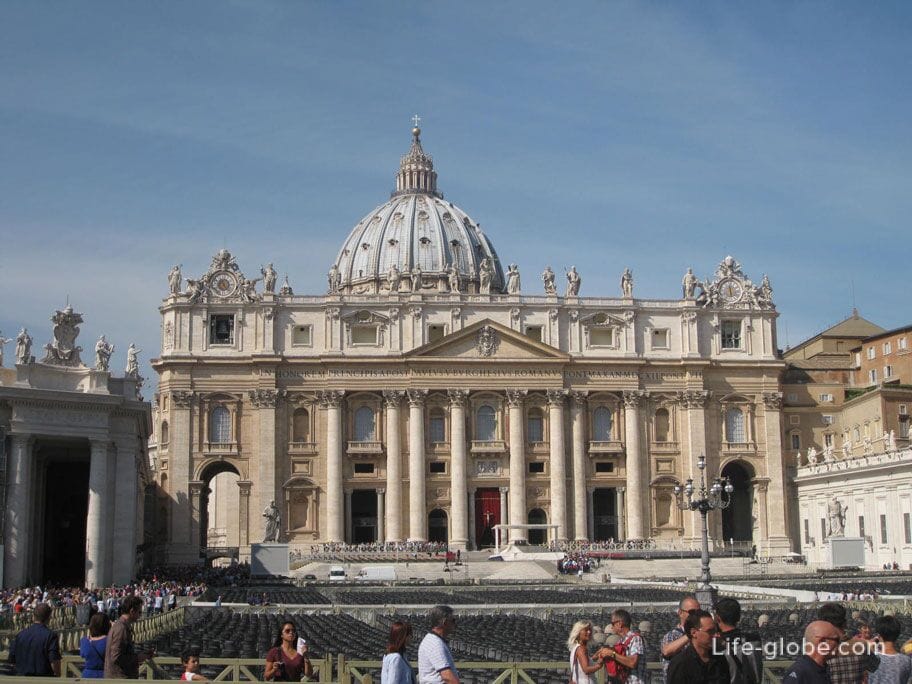
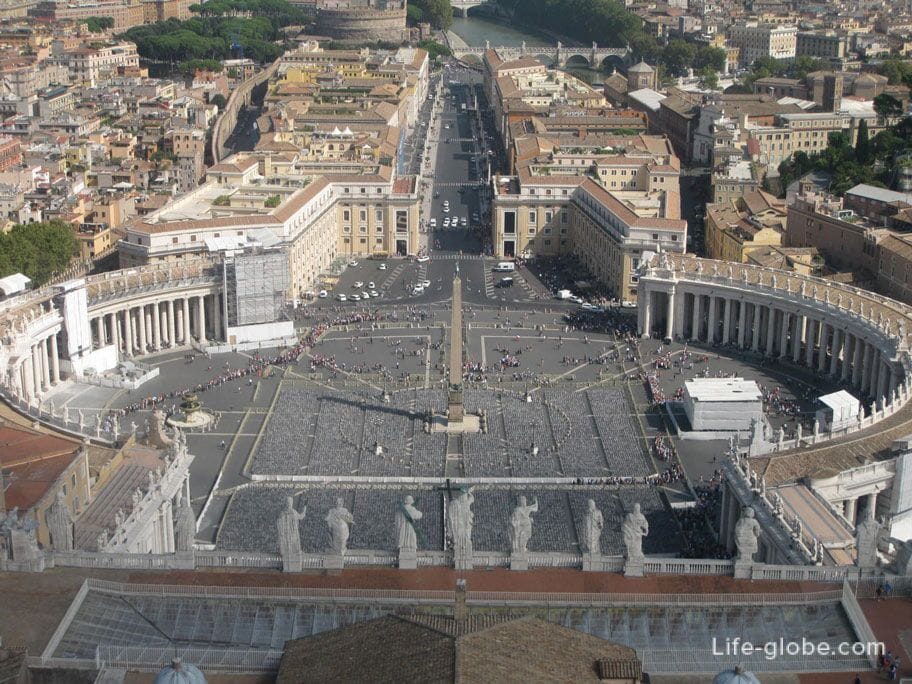

Colosseum
The Colosseum (Colosseo), the Roman amphitheatre, currently bearing the status symbol of Rome.
The main purpose of the Colosseum in Rome were the gladiatorial fights.
Now the Colosseum is a magnificent ruins, the most ancient monument of architecture, on the creation of which I took the great masters thousands of slaves, specially brought to Rome for the construction of the Coliseum by order of the Emperor of tyre, who worked day and night. Also the Colosseum was included in the list of one of the seven new wonders of the world, which, rightly considered, is the great creation of human hands.
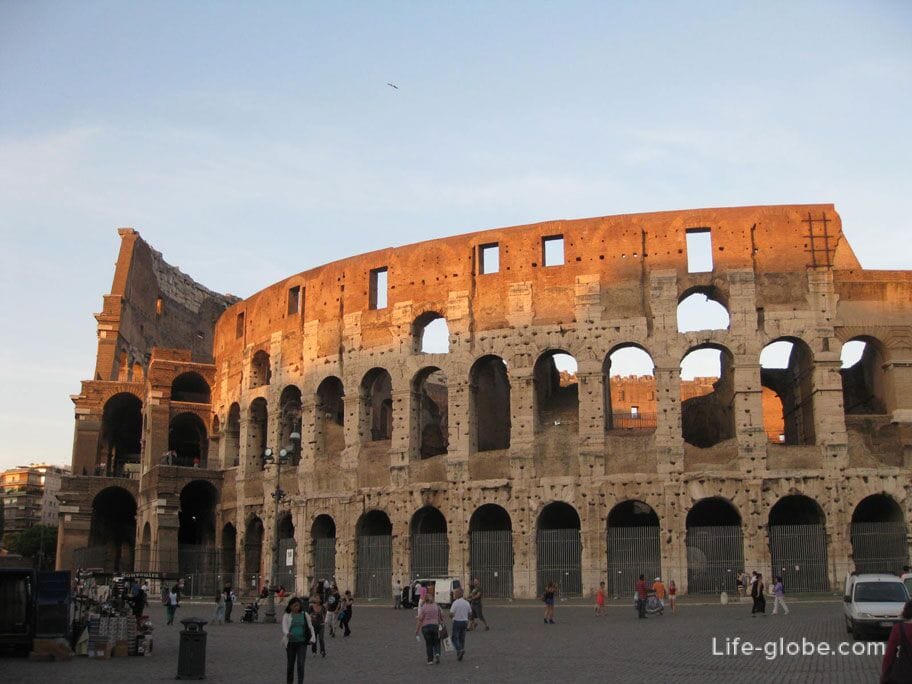
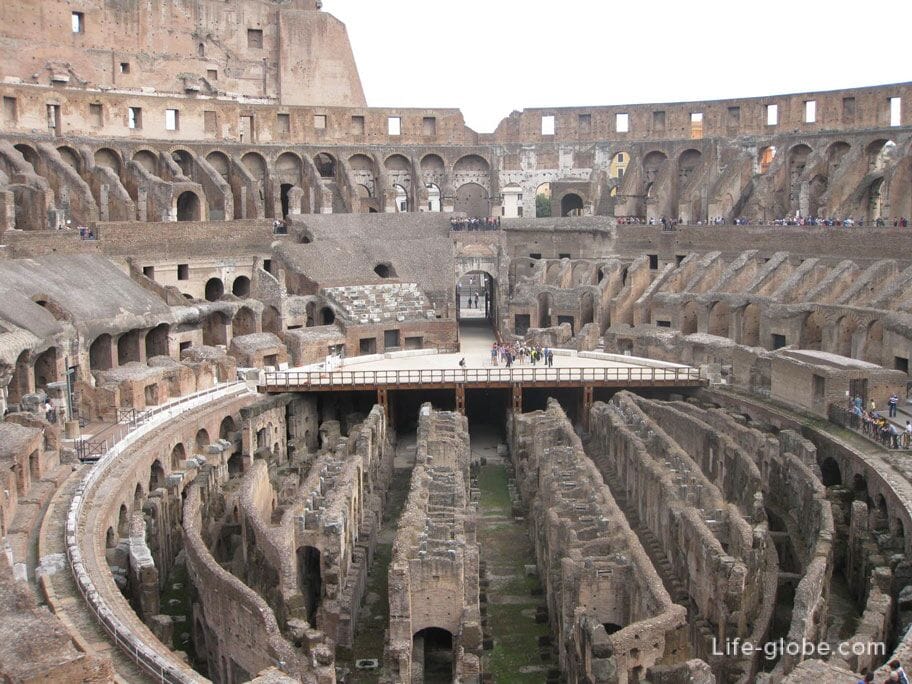
The Roman Forum and the Palatine
Roman forum (Foro Romano) - the heart of Ancient Rome. Currently, the Roman Forum is a complex of historical and architectural monuments, located near the Colosseum. On the territory of the Roman Forum preserved a series of ancient columns and ruined arches of the temples, the Sacred Roman road, the Arch of Titus, the half-ruined Temple of Venus and Roma II, Basilica of Cosmas and Damian, as well as other significant dominant, temples and palaces.
Platinum (Palatine hill)/ Palatino one of the seven hills on which there was Rome. There is a single ticket for the Colosseum, Roman Forum and Palatine hill. The forum and the Palatine are one territory, and if you go beyond the ruins, and back you are not coming in.
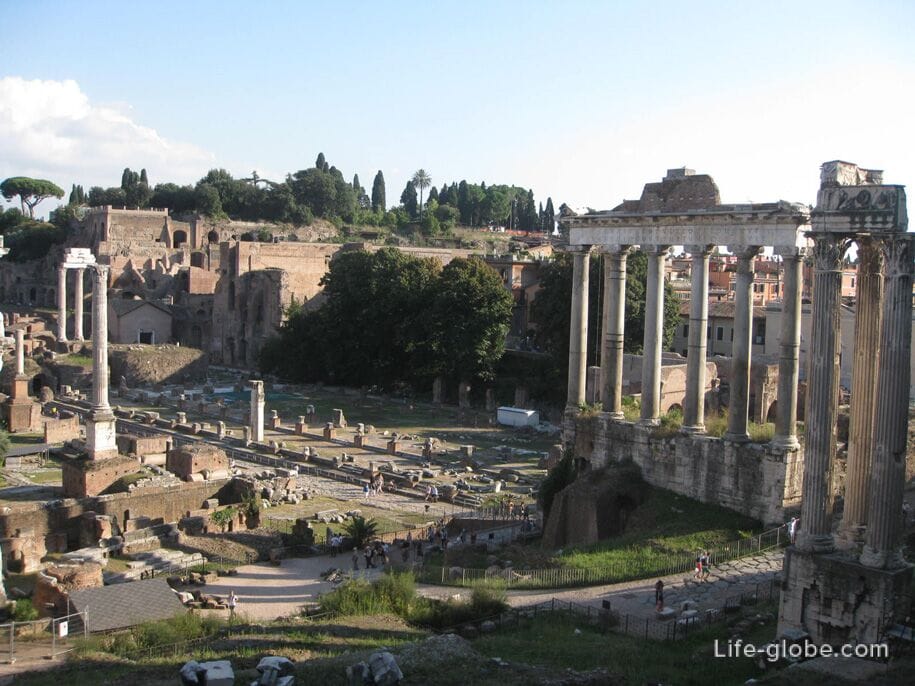



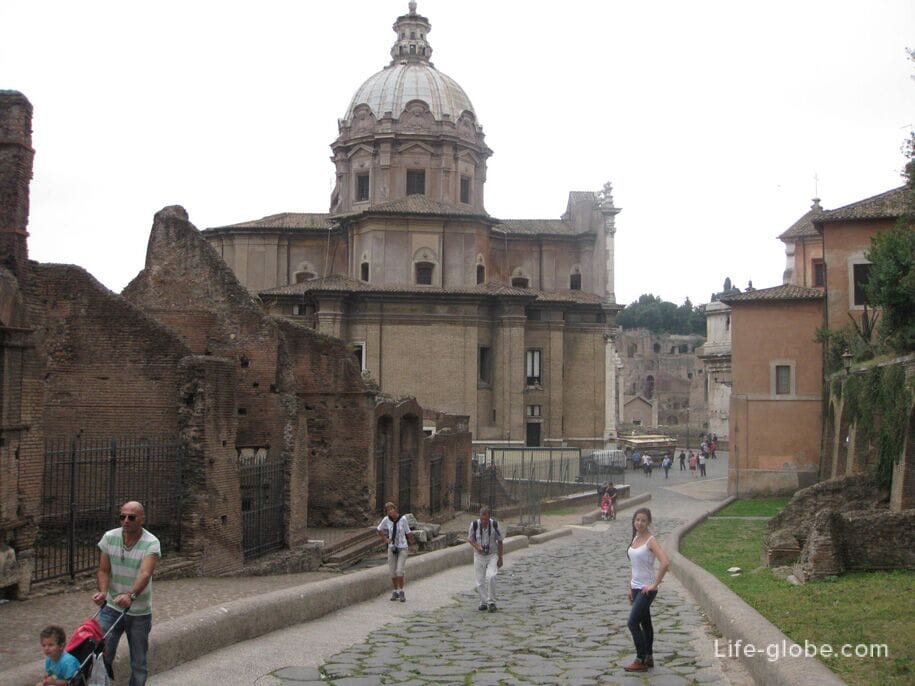
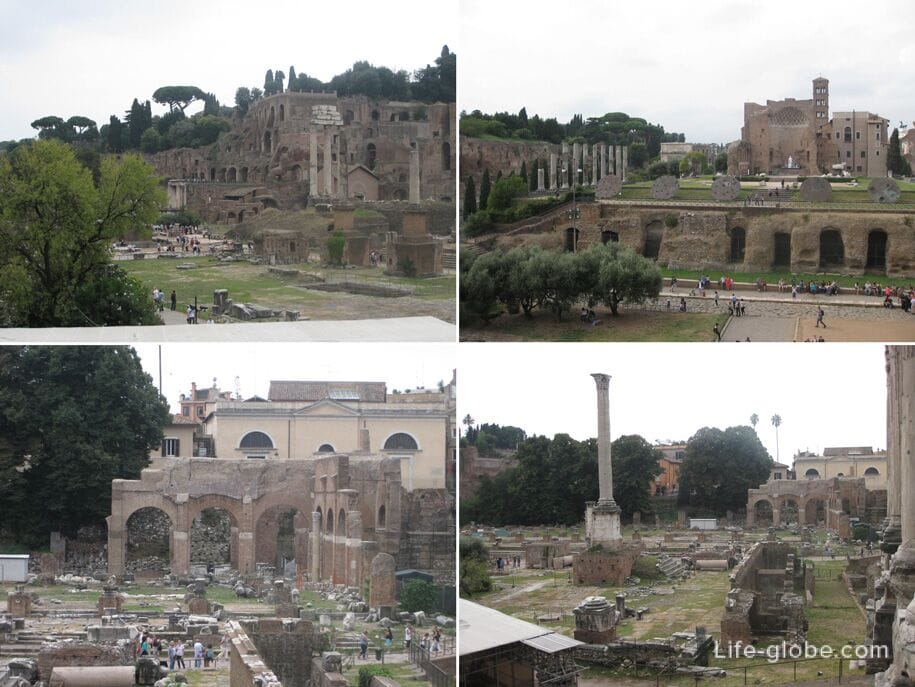
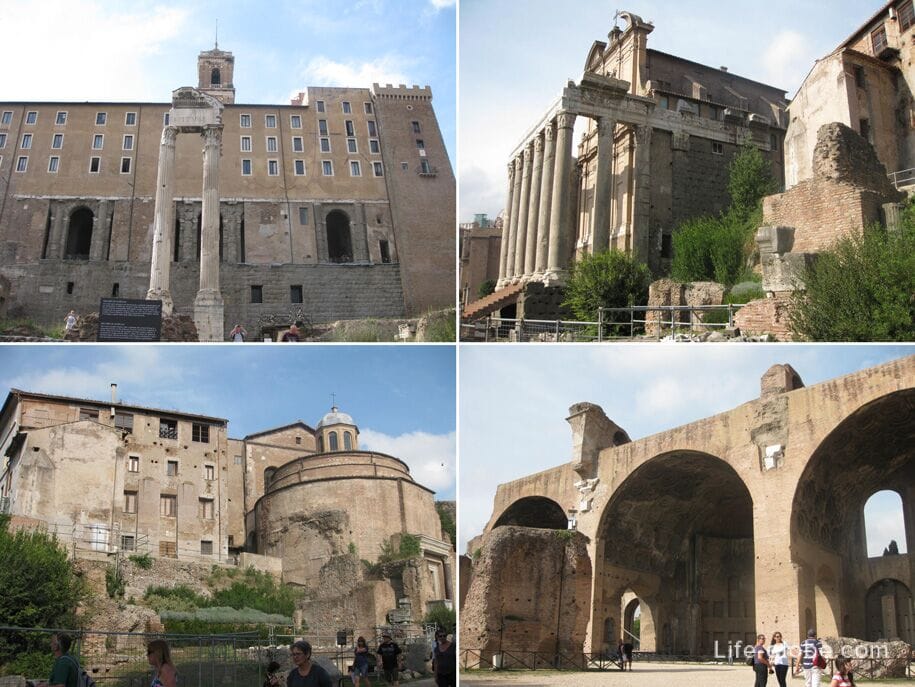
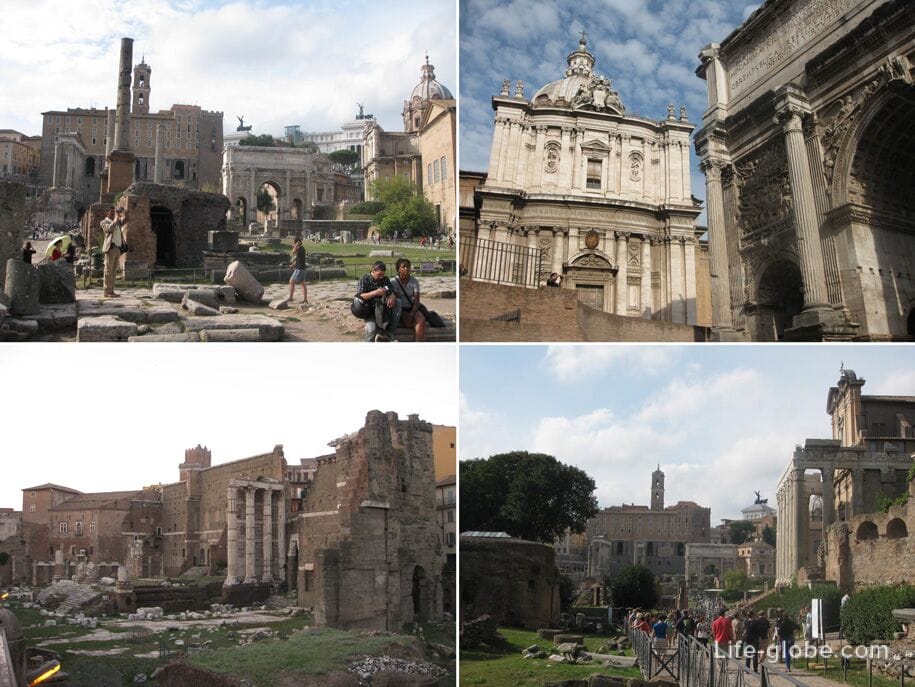
Piazza Venezia, the Palazzo Venezia and the Vittoriano
Roman Square of Venice is a famous and vast square located in the heart of the Italian capital. It is from this square that, as a rule, all sightseeing tours in Rome originate. Piazza Venice gives rise to the main streets of Rome.
Dominates the Piazza Venezia stands the Vittoriano (the Vittoriano) is a monument erected in honour of king Emmanuel II and serves as a symbol of the United Italy.
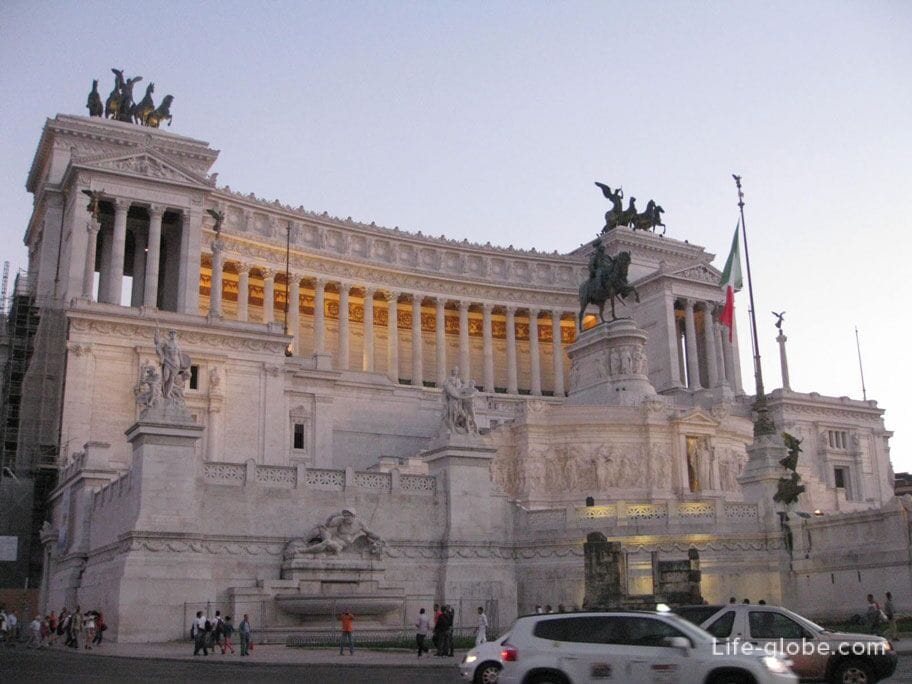
The symbol of the Palace stands the statue of the Vittoriano, or "Altar of the Fatherland" (Altare della Patria). The second name of the statue was due to the fact that at the foot of the equestrian statue is the grave of the unknown soldier. At the grave constantly on duty a guard of honor.
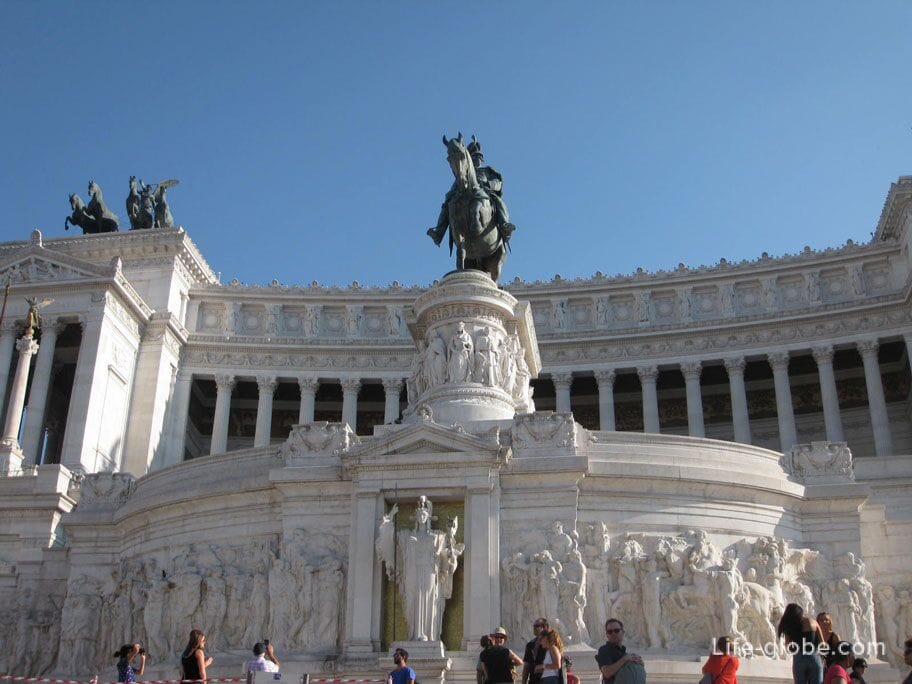
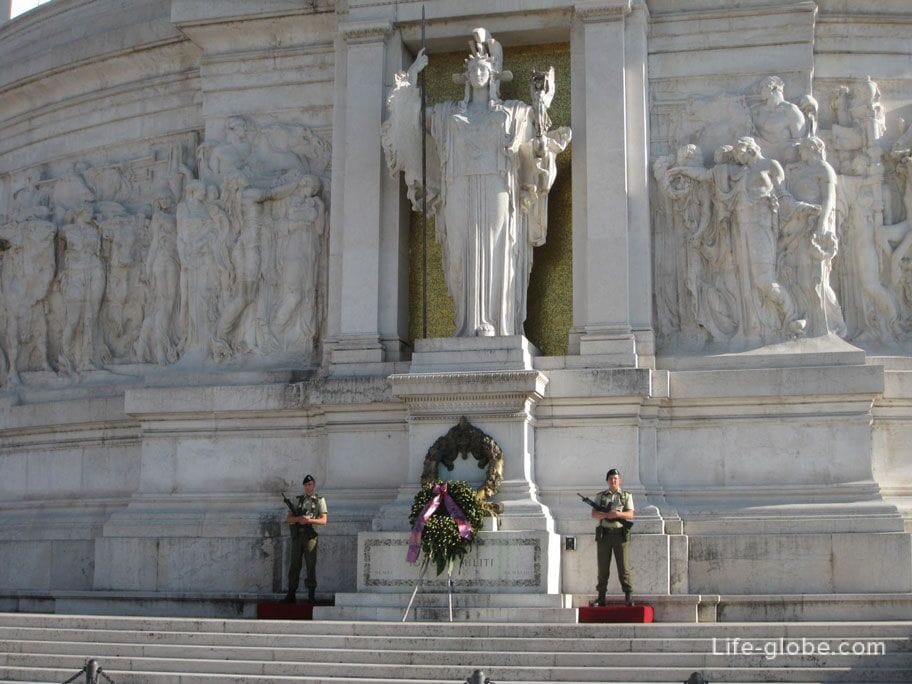
Capitol hill
Capitol hill is a legendary place, one of the seven hills on which once was founded Ancient Rome. Today Capitol hill is a historic site, a Museum under the open sky, on the Piazza del Campidoglio (Piazza del Campidoglio), Capitoline Museum, staircase Michelangelo, statues, palaces, viewpoints and the famous Basilica of Santa Maria in Aracoeli (Santa Maria in Aracoeli), the Church of the virgin Mary, located on top of Capitol hill.
Basil, due to its Central location has played a crucial role in the life of medieval Rome. Among the treasures of the Capitol, the Basilica it is possible to allocate the relics of St. Helena, tomb of Pope Honorius IV, tombs of various aristocratic families of Rome with tombstones made by Donatello and Michelangelo, as well as the cycle of frescoes by Pinturicchio brush.
The whole complex of Capitol hill is located close to Piazza Venezia.
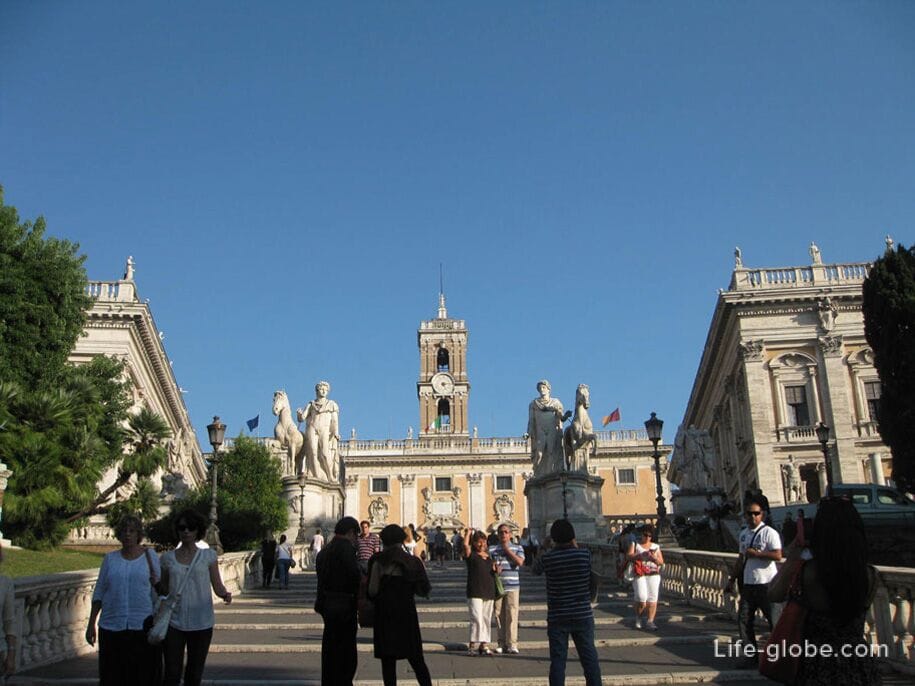

The Forum Of Trajan
Not far from Piazza Venezia and the Vittoriano is the Forum of Trajan (Forum Traiani). The forum of Trajan is an ensemble of architectural monuments and is chronologically the last of the Imperial fora of Rome.
Trajan's forum was built by order of Emperor Trajan. Construction began in the year 106, and the opening took place in 112 year. Designed as a forum a favorite of the Emperor Trajan by the architect and sculptor of the second century of our era - Apollodor from Damascus.
Now the forum, like all forums of Rome, represents the ruins of historic and architectural value.
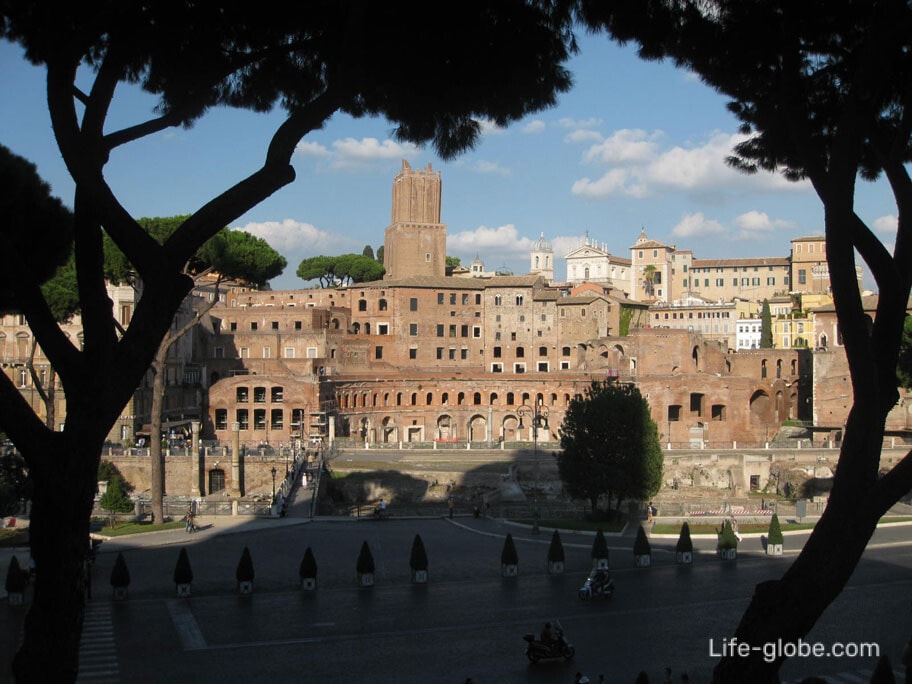
Within the forum are: the Trajan's market Museum of the Imperial forums; Trajan's column; but near the ruins of the forum are two great dominant Church of the Holy name of Mary and the Church of Santa Maria di Loreto.
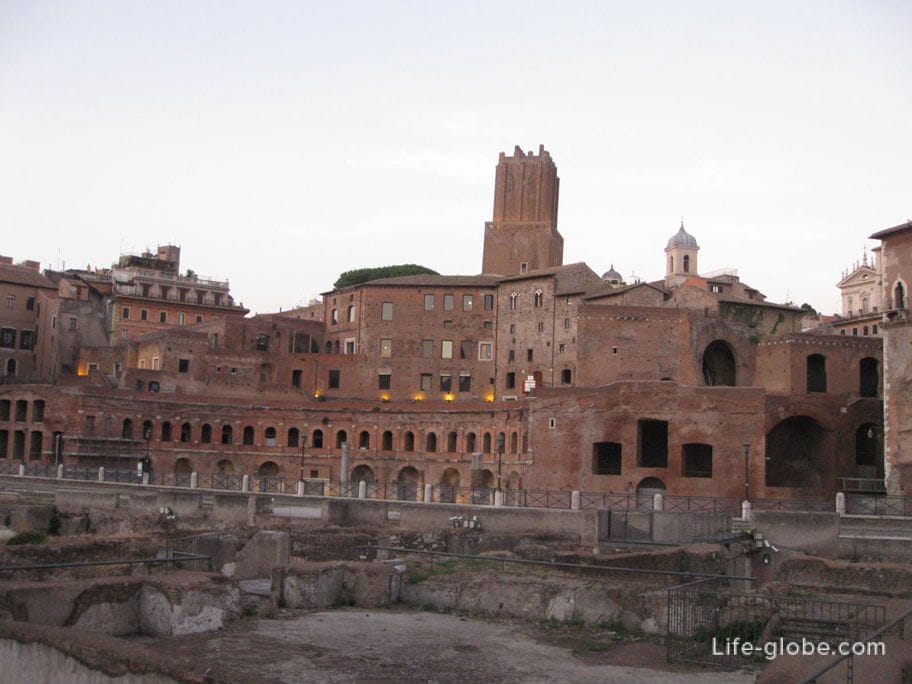
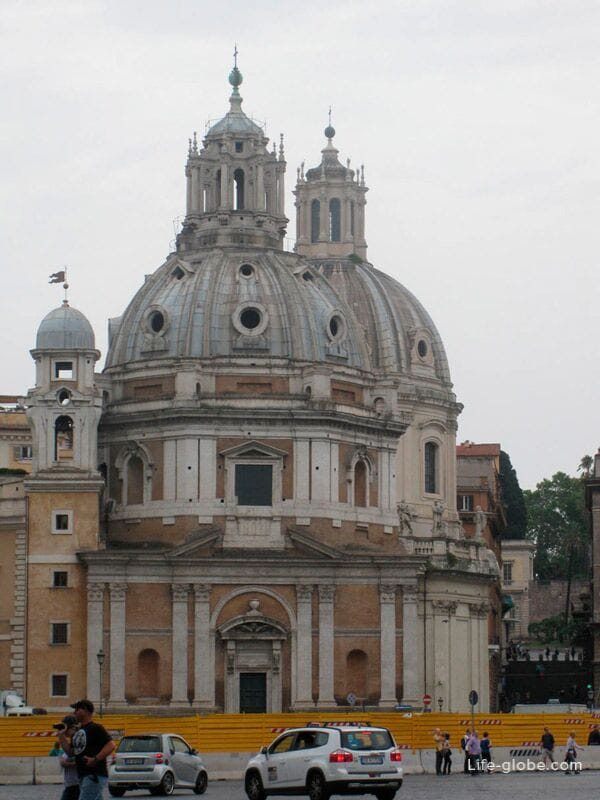
The Trevi Fountain
The main, most famous and largest fountain in Rome!
Fountain di Trevi (Fontana di Trevi or Trevi Fountain) is considered the architectural jewel of Rome, every day gathers hundreds of tourists. The fountain itself is already fairly impressive size, and because it is adjacent to the facade of the Palazzo Poli (Palazzo Poli), the majestic facade of the Palace and the fountain near it are visually perceived as a single whole, from which creates a stunning effect in a fountain of enormous size. Yes... Architect Nicola Sylvie coped with the task perfectly.
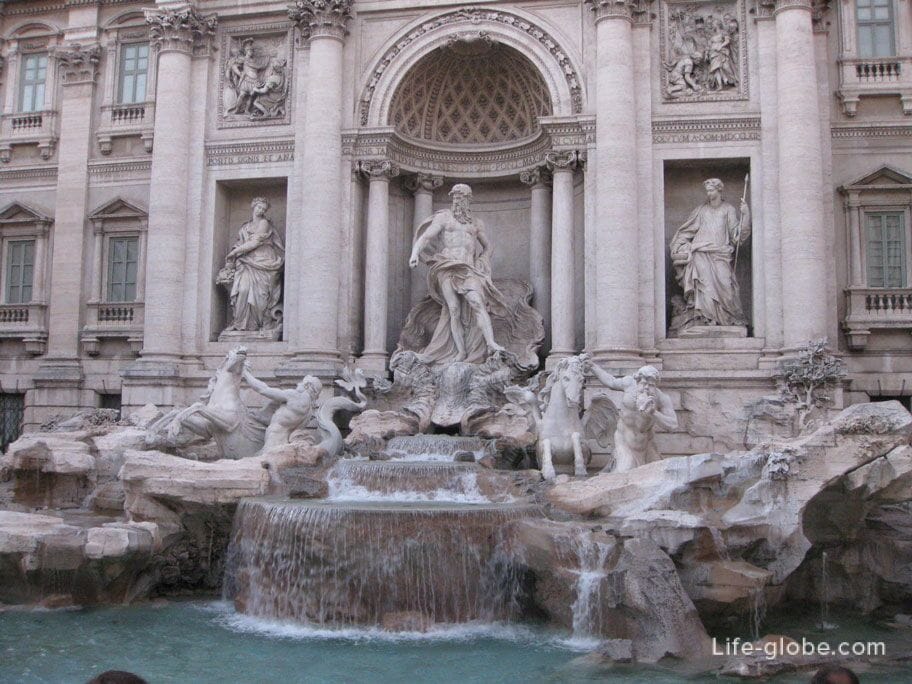
The Pantheon and Piazza Rotunda
Pantheon - one of the oldest and most visited attractions of Rome. It is also a historical and architectural monument of Ancient Rome, the legacy of the Renaissance.
The Pantheon literally translates as ham of the Gods. The Roman Pantheon for over two thousand years, it was erected in place of the previous Pantheon, built by mark Vipsanius Agrippa between 27 and 25 BC as a temple dedicated to the twelve gods and the Monarch.
The Pantheon is in Piazza della Rotonda (Piazza della Rotonda), or simply as it is popularly called, Piazza del Pantheon and Piazza Rotunda.
This small but quite cozy area is located at the main entrance to the Pantheon. Around the area you can see buildings built in several architectural styles. The perimeter of the area located hotels and cafes with open terraces, and in the center it is decorated with the eponymous fountain - Fontana del Pantheon.
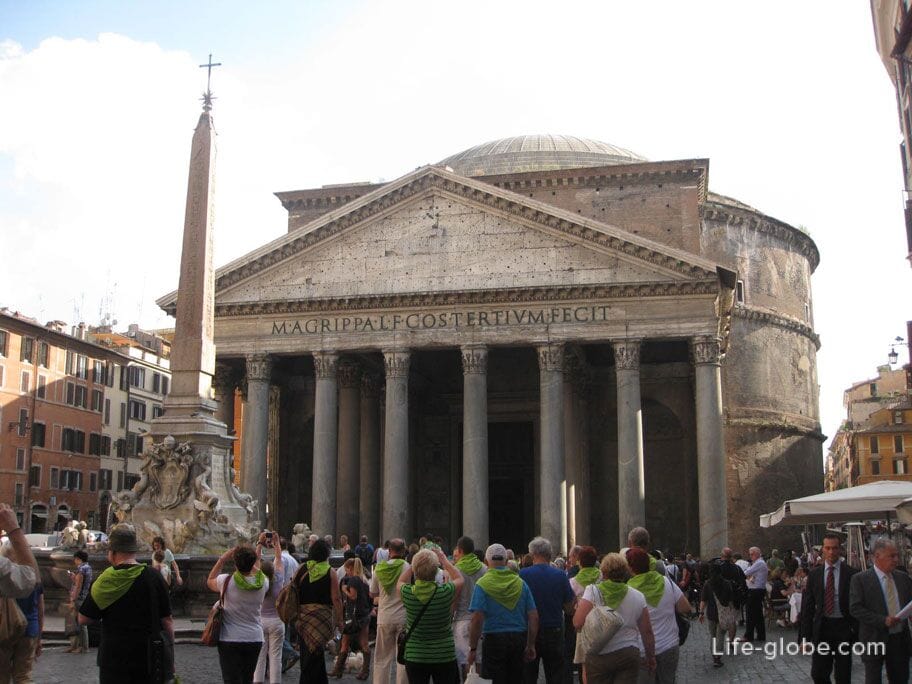
Currently, besides the historical and architectural heritage, the Pantheon attracts special attention with its interesting and unusual architecture. The fact that Pantheon has no Windows and the only source of light is a large round hole, diameters of 9 meters, located in the dome of the Pantheon. It is through this opening and lots of light inside the Pantheon, illuminating the interior.

Castel Sant'angelo
The castle of the Holy angel , or, as it is called, Sant'angelo, or the mausoleum of Hadrian (the Italian name of Castel SantAngelo English Castle of the Holy Angel), is located in the eponymous Park and Hadrian's is a monument of history and architecture of the Ancient Rome period. Not a single guide to Rome will bypass this lock and put it on one of the first places on the recommendations to visit.
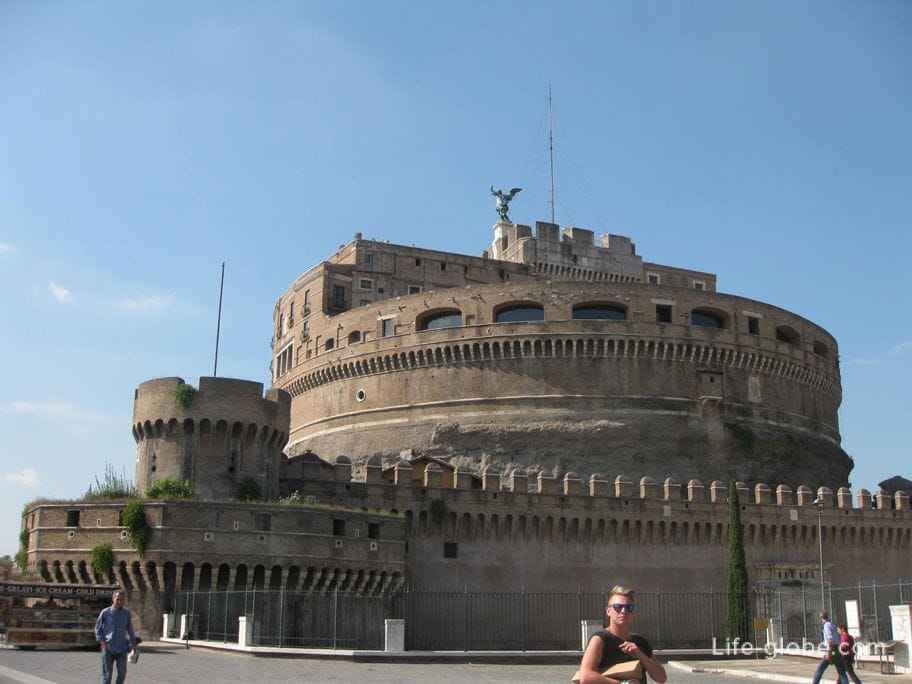
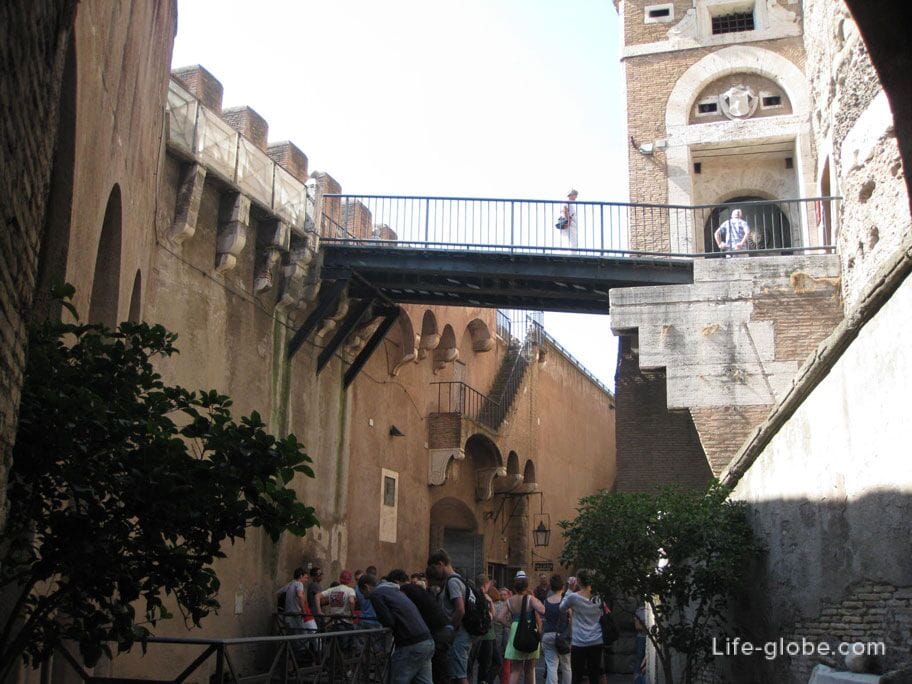
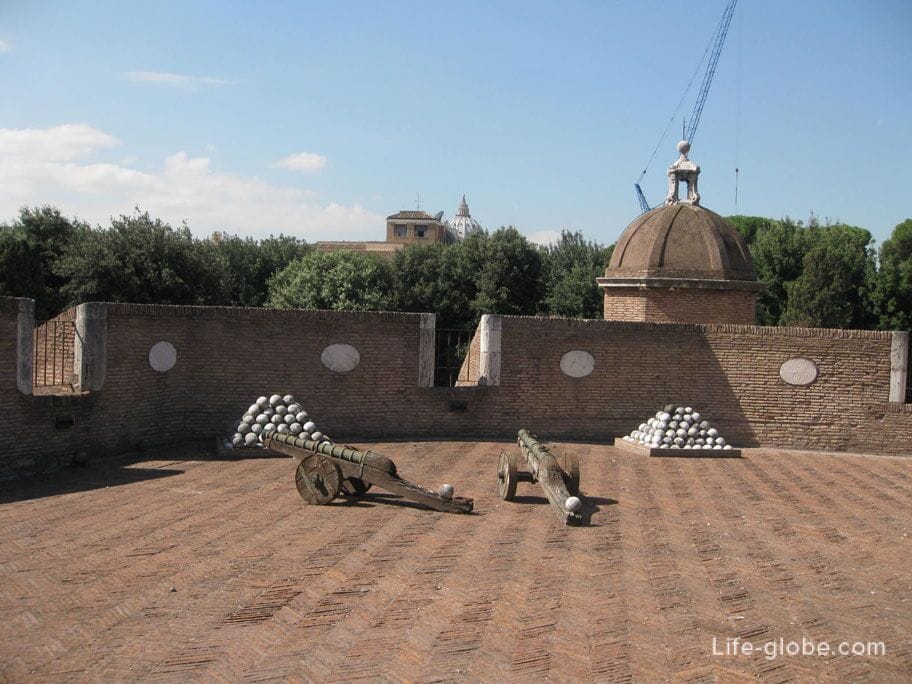
Bridges of Rome - Sant'angelo and Victor Emmanuele II
In Rome, over the Tiber river, lies a lot of bridges, bridges are literally every 100-300 meters and they are all equally good, represent the historical and architectural value and each of the bridges are beautiful in their own way. However, among all the bridges, it is possible to allocate two most beautiful and memorable.
Ponte Sant'angelo or Aliev bridge in Rome
St. Angelo bridge (ponte Sant'angelo) is one of the oldest pedestrian bridge in Rome. The bridge was built in 134-139 years of the Emperor Hadrian. The length of the bridge is 135 meters, from the outside it is a marble.
Originally the bridge was not sculpture. But in the sixteenth century there was formed the custom to hang on the bridge the bodies of executed criminals. It was then on the bridge there are statues of the apostles Peter and Paul. Later the statues of the two apostles already installed with the filing of Bernini added another ten statues of angels. Two of these original statues are kept in the Church of Sant'andrea delle Fratte.
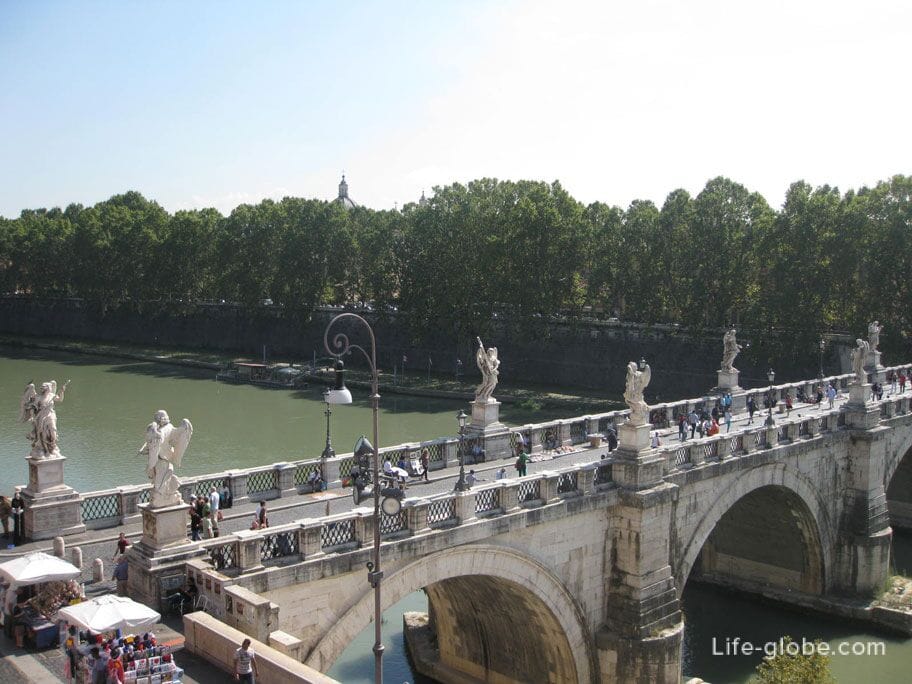
The bridge of Vittorio Emanuele II in Rome
Bridge Victor Emmanuel II (ponte Vittorio Emanuele II) is located near the bridge of Angels, just steps away from the last, slightly downstream.
This pedestrian bridge over the Tiber river decorated with sculptures on both sides. The edges of the bridge there is a bronze statue depicting a Winged Victory with a military Arsenal, a broken chain and a wreath of flowers. On batteries the Central arch there is a marble sculptural group of allegorical figures, symbolizing freedom and unity. In addition, the bridge is richly decorated with relief detail and anthropomorphic images.
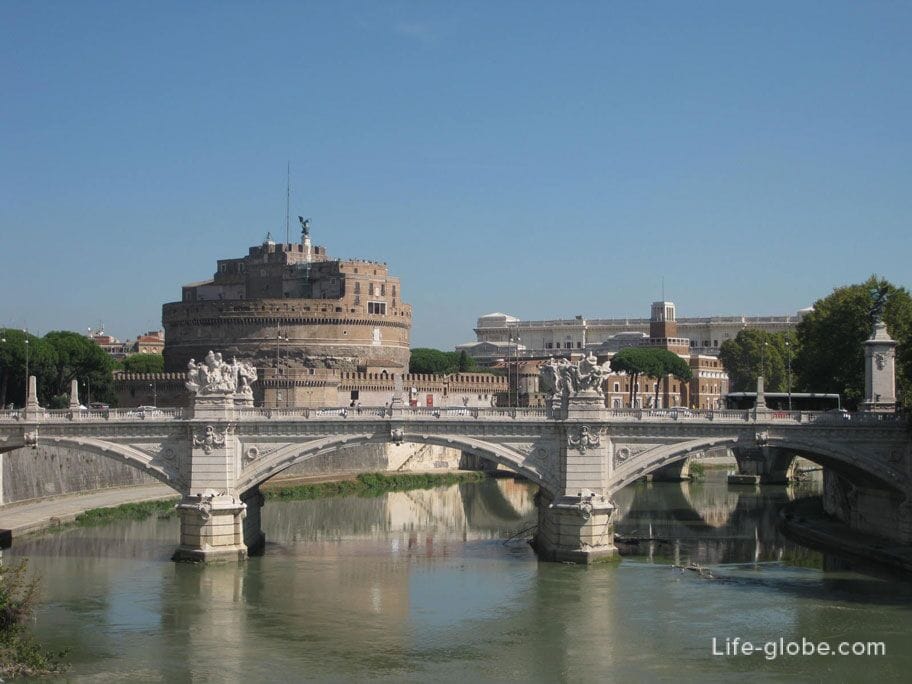
Piazza Navona and fountain of the Four Rivers
Piazza Navona (Piazza Navona) - the world famous Roman square, having an elongated shape. This is one of the most visited and most beautiful squares of Rome's historic centre.
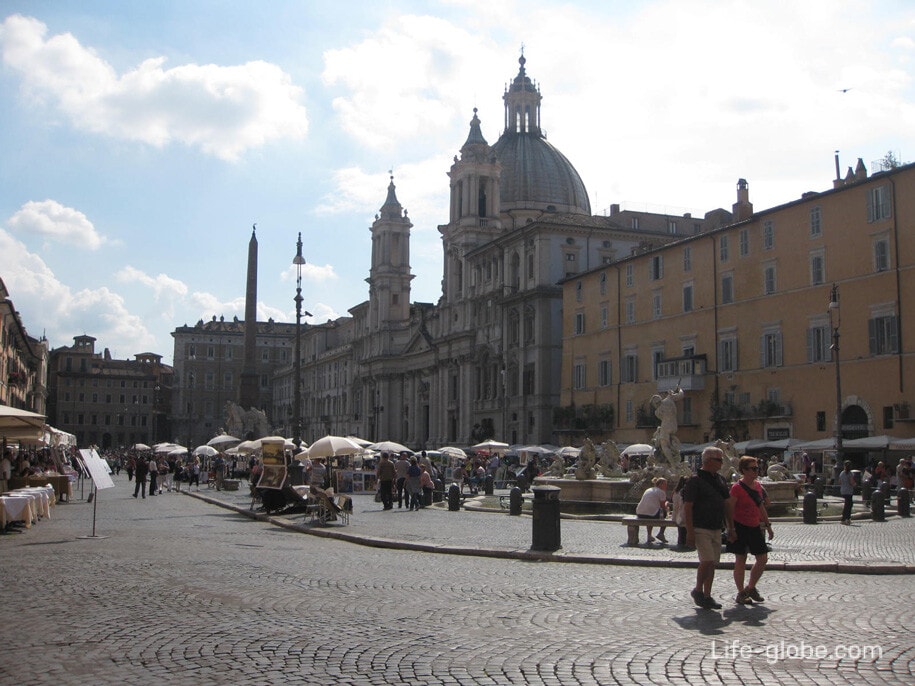
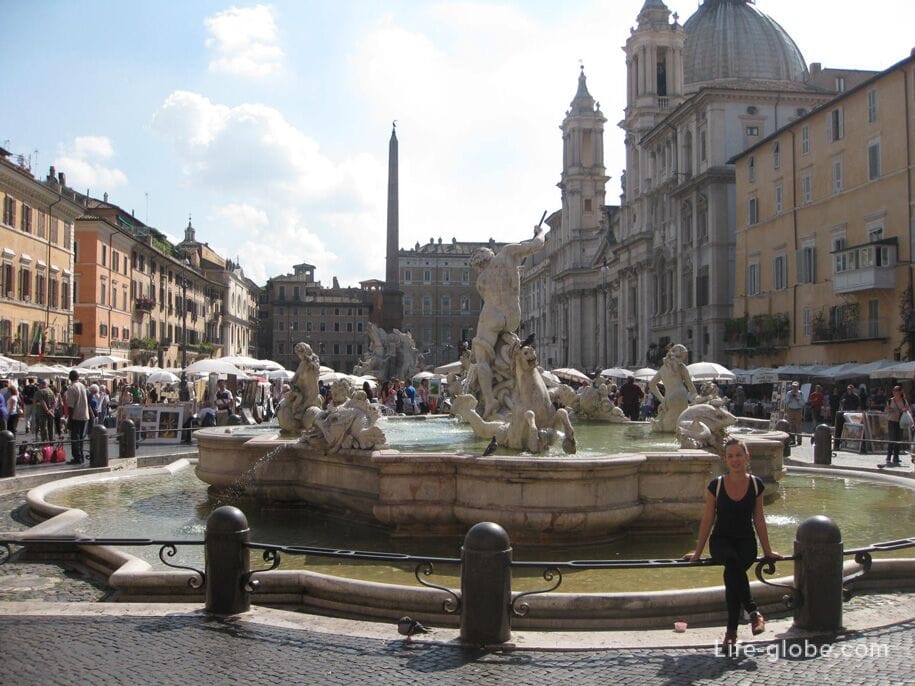
On the square are three small fountains, each good in its own way and has beautiful architecture.
The fountains of the moor and Neptune are the two ends of the square. The center stands one of the finest and most famous fountains of Rome - fountain of the Four Rivers (Fontana dei Fiumi) in the center of which can be seen in the heavens australasica obelisk - Obelisk Agonale in Piazza Navona
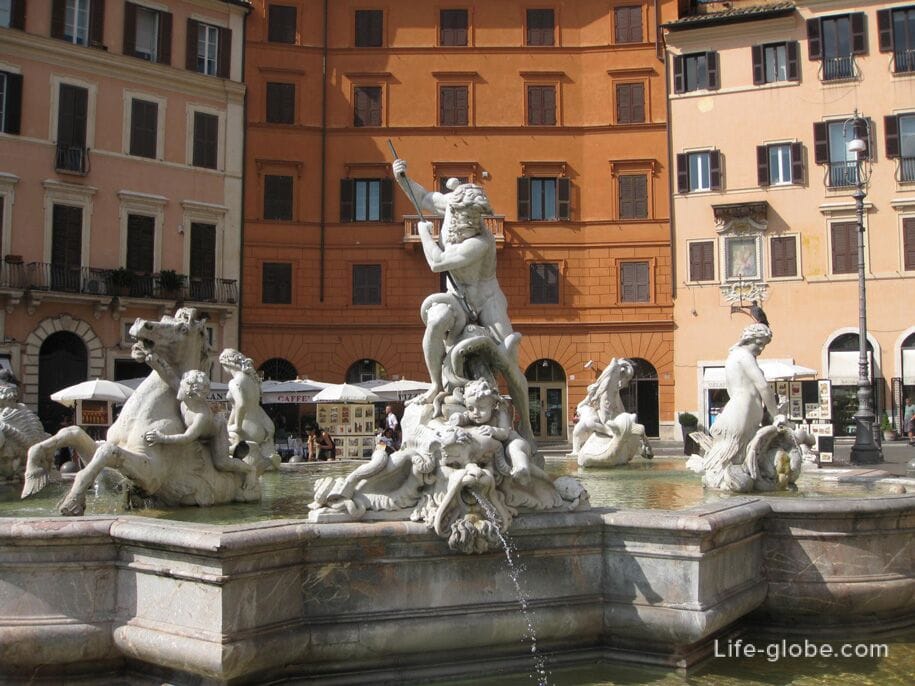

Around the perimeter of the square is decorated buildings, among which the Catholic Church, the General Consulate of Brazil hotels, a Museum and cultural center, numerous cafes and restaurants. Among the many buildings around the square, a landmark and architectural masterpiece is the Church of Sant'agnese in agone (Sant'agnese in Agone).
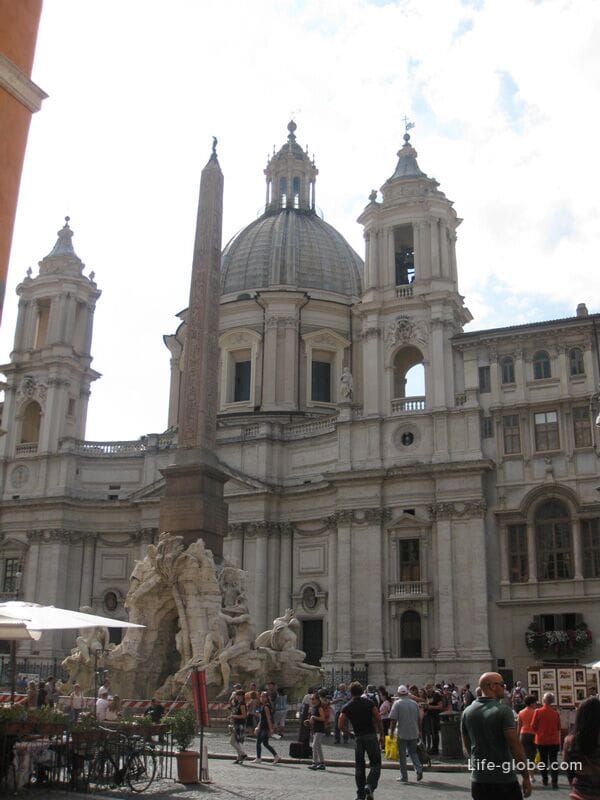
Spain square and the Spanish steps
Spain square, Piazza di Spagna (Piazza di Spagna) is one of the well-known and visited squares in Rome. Located square in the center of Rome, in the Campo Marzio and walking distance from Cathedral of St. Peter.
This seemingly strange Italian name, the square of Spain was due to the fact that on the territory of Piazza since the 17th century housed the Spanish Embassy.
In the center of the square, at the foot of the Spanish steps is the Barcaccia fountain (Fontana della Barcaccia) designed in the Baroque style, in the form of a small boat. The composition of the fountain built by the Italian sculptor Pietro Bernini. The name "Barcaccia", that is, the boat, the fountain has received its half of the boat.

The fountain originates the Spanish steps. This ladder is so famous, the lovers often date. Also the Spanish steps have featured in many movies and literary works. On the top of the Spanish steps, in the Northern part of the Piazza Spagna is the titular Church of Trinita dei Monti (the Santissima Trinita al Monte Pincio)
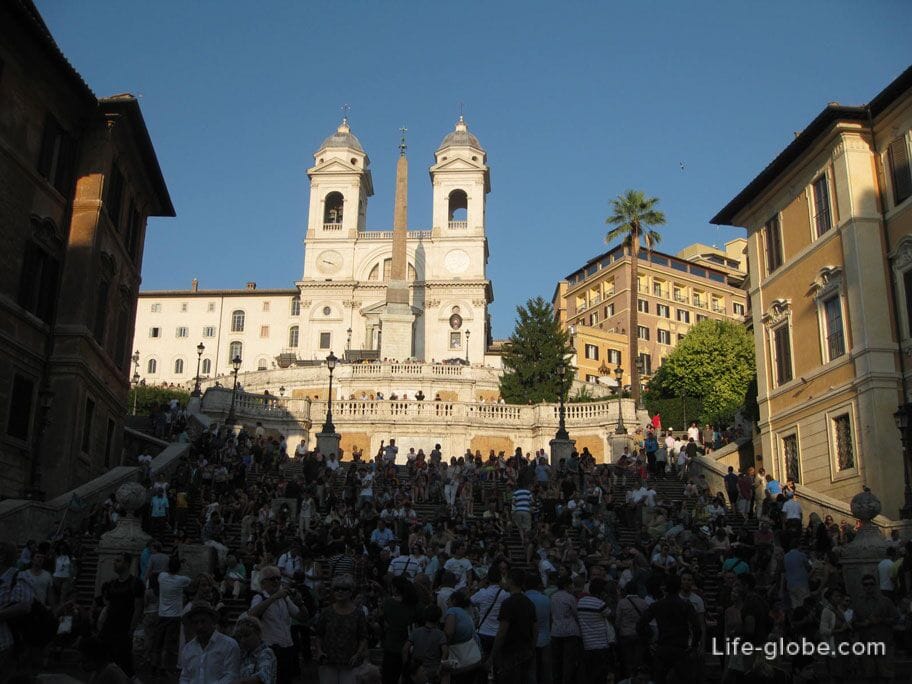
Piazza del Popolo and the Pincio gardens
Del Popolo square (Piazza del Popolo) with its architectural heritage is one of the largest, most beautiful and elegant squares in Rome.
Popolo the square is located at the foot of Pincio hill and the common people is called people's square.
The kind of square that we can see today, the Piazza acquired only in the years 1811-1812, thanks to the architect Giuseppe Valadier.
Historically (until 1826), Piazza del Popolo was place of public executions. At present, this spacious and beautiful area, completely closed to vehicular traffic, where there are cafés and restaurants, performing street artists and musicians, and on holidays here set the stage and concerts.
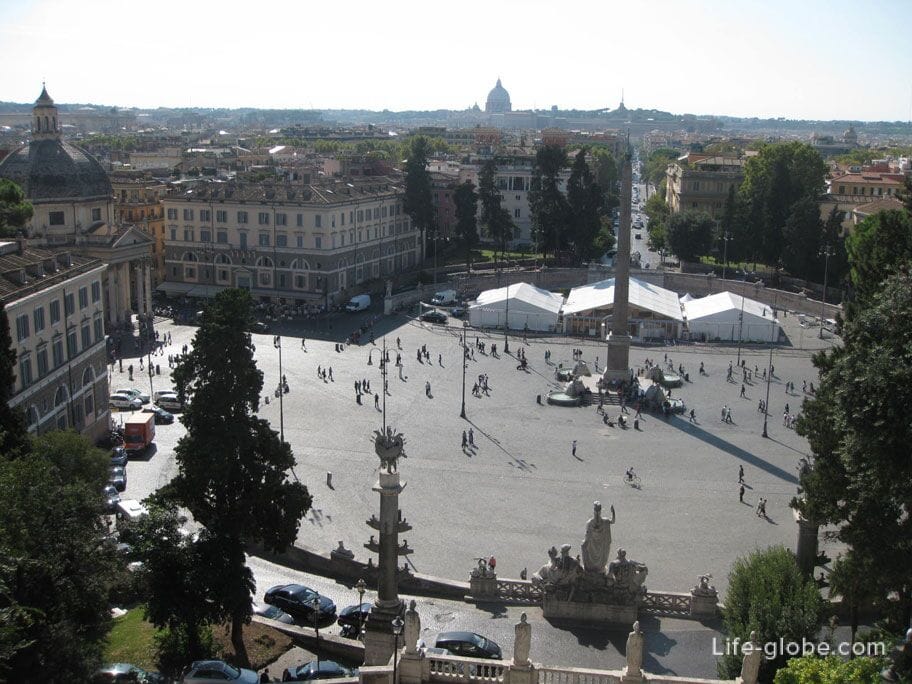
In the center of the square stands a 36-meter Egyptian Ollicc Flaminio (L Obelisco Flaminio). The name of the obelisk Flaminia is connected with the name of the ancient via Flaminia, which originates from the Piazza Popolo, and is considered an ancient pilgrimage road.
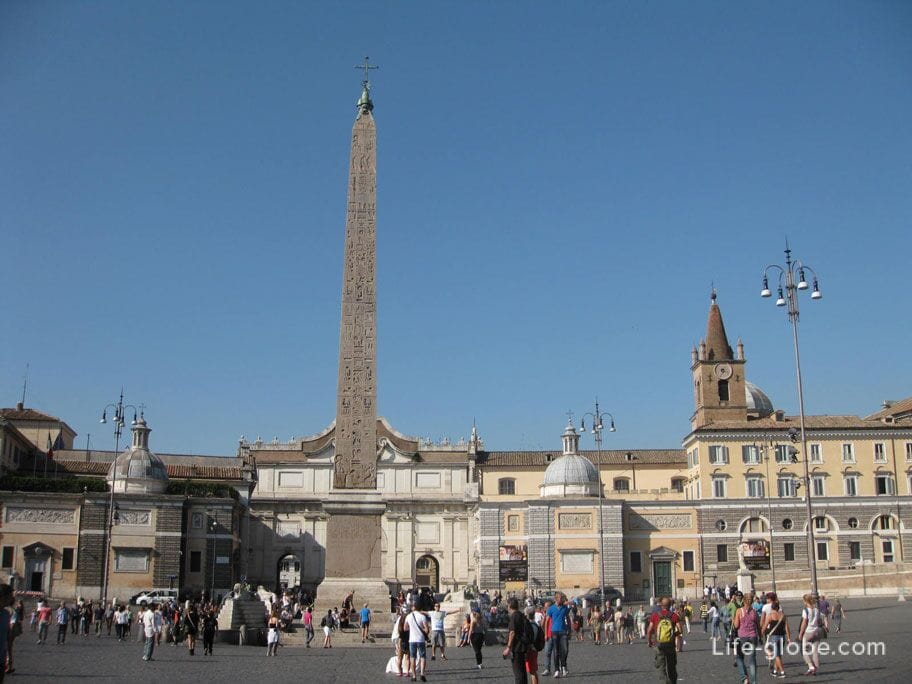
In addition to the obelisk in Popolo square is decorated with five fountains, four of which are of small size, located at the four sides of the obelisk, at its base. Fountains circular shape, which depicts a pyramid with noslegusies them marble lions, exact copies of ancient Lviv. From the mouth of each statue of a lion beat jet of water. To the obelisk and fountains are stairs, which love to relax like the locals and guests of the city.

The fifth and most majestic and beautiful fountain in Piazza del Popolo square is the Fontana della DEA di Roma (Fontana della Dea di Roma).

On the perimeter, Piazza Popolo, decorated with beautiful basilicas and churches. Of the most significant:
- the ancient Church square - Basilica of Santa Maria del Popolo (Basilica Parrocchiale Santa Maria del Popolo). To the left of cerci you can see the Northern gate of Rome - the gate del Popolo (Porta del Popolo). Popolo is a gate called the gate Flaminia. From the gate runs Flaminia pilgrimage road (Via Flaminia), in the Middle ages known as the Ravenna road. That is way over the centuries arrived in Rome the bulk of the travellers.
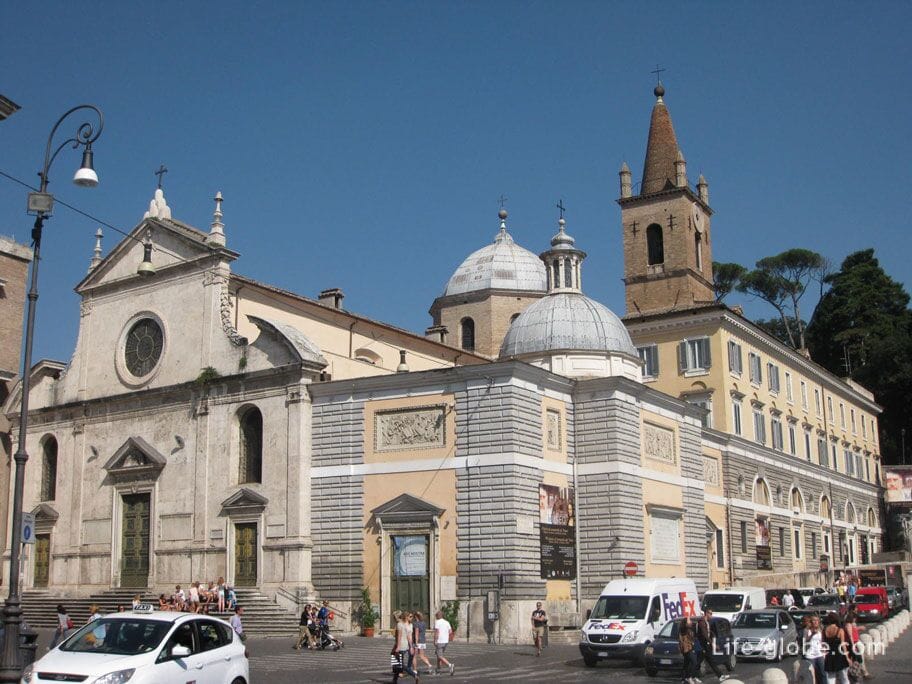
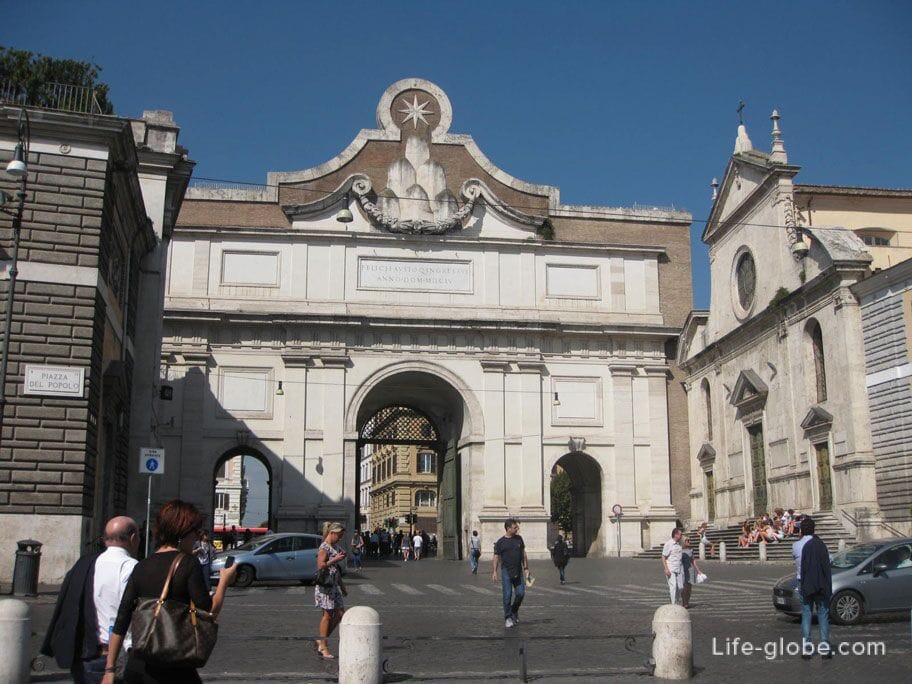
- two twin brothers - the two like each other basilicas: Santa Maria Montesanto (Santa Maria in Montesanto), Santa Maria dei Miracoli (Chiesa di Santa Maria dei Miracoli).
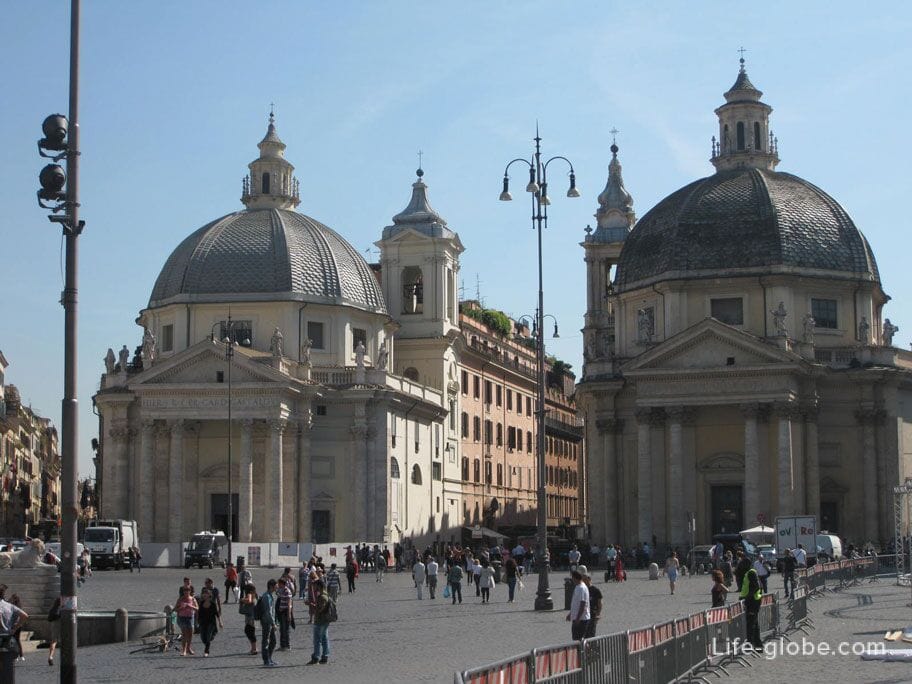
Pincio Gardens
Popolo the square is located at the foot of the Pincio hill (Pincio Italian name, Latin Mons Pincius). Pintxos - one of the Roman hills. However, this hill does not belong to the seven classical hills of Rome, although covered by Aureliano wall.
This interesting name of a hill - Pinch, comes from a family Pinchev, who once owned large possessions on the hill.
Currently on the hill are green Pincio gardens, broken in the era of classicism under the project of Giuseppe Valadier. Hill Pinch in addition to green gardens, are: the observation deck, pond, small area, cinemas, museums and Biopark (zoo).
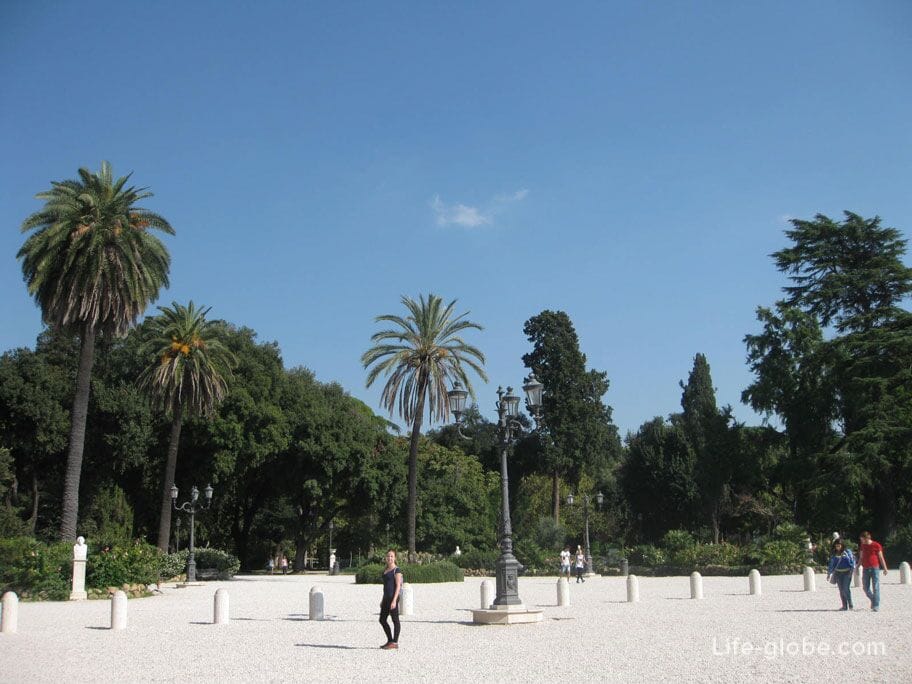
Republic Square
Obscure Republic square (Piazza della Repubblica), is not as beautiful as other areas of Rome, however, insignificant. From the square starts one of the main streets, via Nazionale, and under the square is the metro station "Repubblica - Teatro del Opera" on line A of the Rome metro.
In the middle, stands the fountain of the Naiads (Fontana delle Naiadi) with a beautiful statue in the middle, created by the sculptor Mario Rutelli in 1901. This fountain has been repeatedly recognized the most beautiful in Rome.

The attractions of Republic square are: interesting architecture, the Basilica of Santa Maria degli Angeli e dei Martiri (Santa Maria degli Angeli e dei Martiri) and the national Roman Museum (Historical Museum of teaching).

The triumphal arch of Rome - Constantine, Titus and Septimius Severus
Triumphal arches, is considered an architectural monument, which is a big solemnly decorated arch. Triumphal arch was installed at the entrance to the city at the end of streets, bridges, wide roads, in honor of the winners or to commemorate important events.
The arch of Constantine in Rome
The arch of Constantine is located near the most famous and important attractions of Rome - the Colosseum and the Roman forum. Like the amphitheatre, the arch of Constantine is the most bright arch of Italy and one of the main monuments and attractions of Rome.
The arch of Constantine (Arco di Costantino) is a fairly large size and is a three-span stone arch.
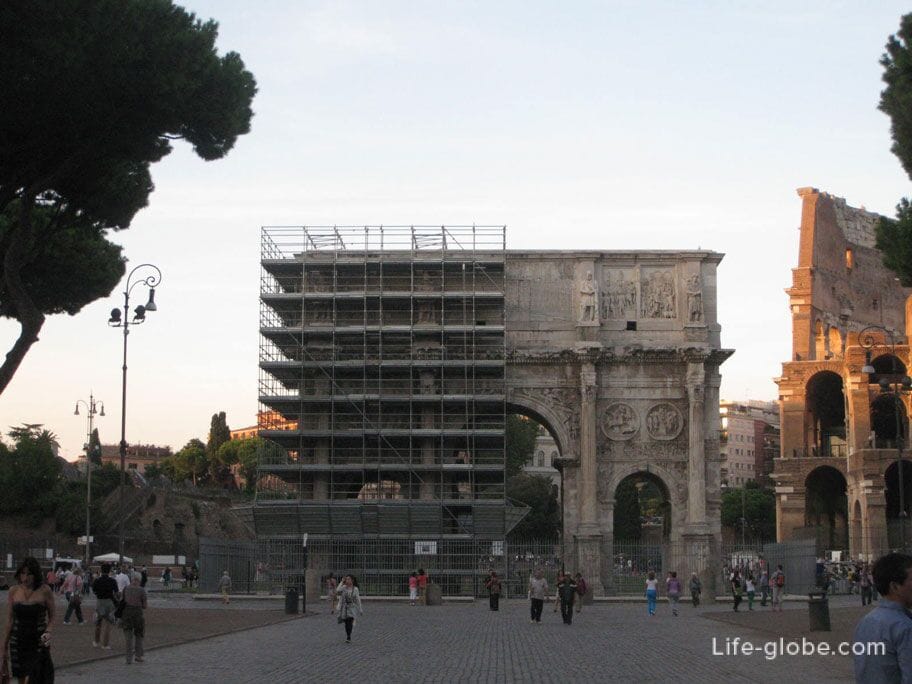
Arch of Titus in Rome
Arch of Titus (Arco di Tito) is the oldest triumphal arch in Rome. Therefore, in addition to architectural, is still pronounced historical significance.
This arch, unlike the arch of Constantine, single span and has a more modest size.
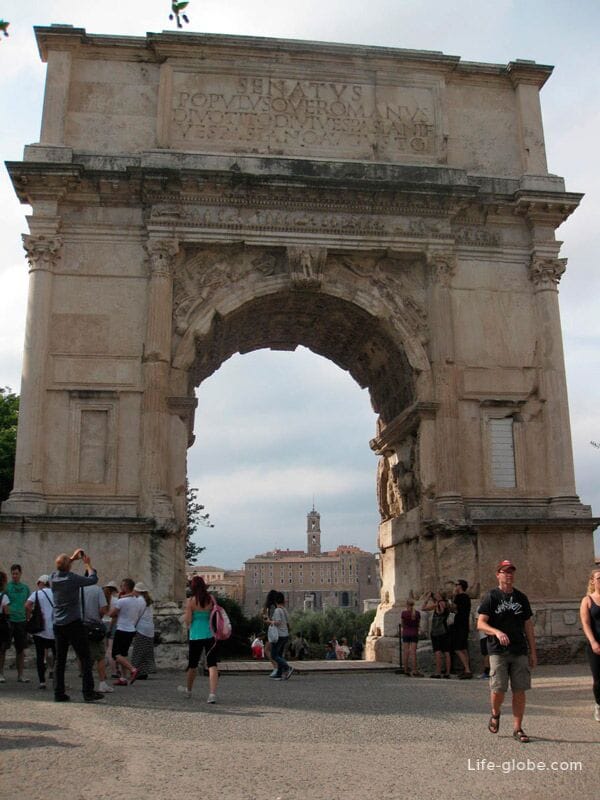
Arch of Septimius Severus in Rome
Arch of Septimius Severus (Arco di Settimio Severo), and the arch of Constantine is a three-span arch, sufficiently well-preserved to our times.
Arch of Titus is located as the arch of Titus, in the ancient Sacred way Via Sacra, in the Northern part of the Roman Forum between the Curia and Rosstroy.
The arch is made of brick and travertine (calcareous tuff). The surface is covered with marble plates. Has a height of over 20 meters, a width of just over 23 meters and a depth of just over 11 metres.

Circus Maximus
Circus Maximus is the largest Hippodrome of the Ancient Rome.
In our days the circus Maximus has entered into ten the most visited historical sites, showing the former power of Ancient Rome. Currently, the circus Maximus in Rome in ruins and used as parkland.
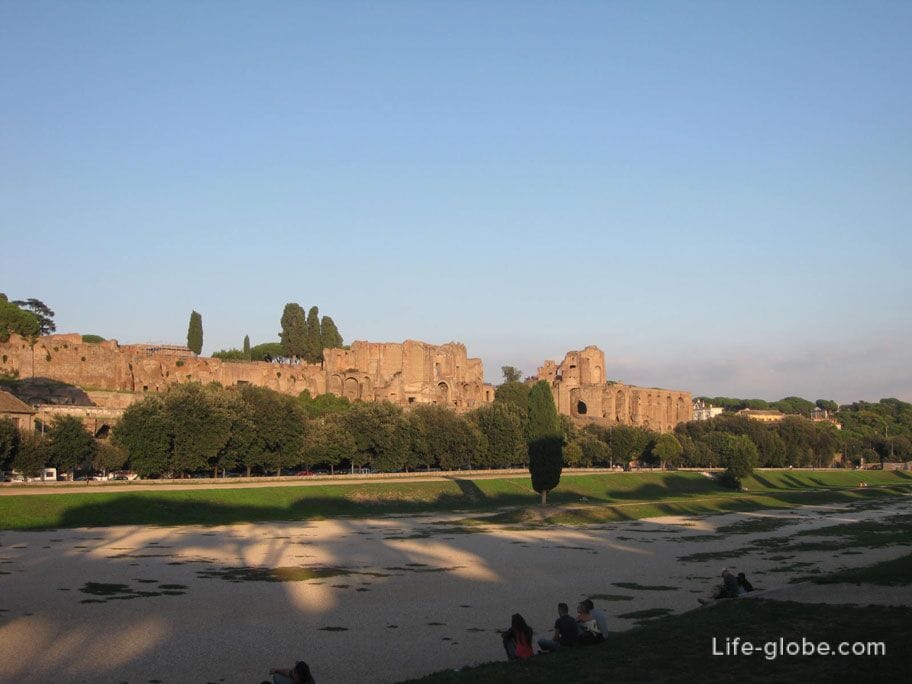
Near the ancient Roman Hippodrome, on Via del Circo Massimo, is another attraction of Rome, the impressive statue - the monument to Giuseppe Mazzini (Monumento a Giuseppe Mazzini).
The majestic monument with beautiful stucco reliefs, a small altar and steps at the foot of the sculpture of Giuseppe. The pedestal of the monument is a large marble block, white colors, on all sides, framed by a continuous frieze. On this stone pedestal displayed the ideas and aspirations of Giuseppe Mazzini - freedom, equality, and triumph in the struggle against despotism and oppression.
At the top of the pedestal stands a bronze sculpture of a prominent Italian politician, writer and philosopher Giuseppe Mazzini.

Museum of the souls in Purgatory
In the heart of Rome to be one of the creepiest museums in Italy - the Museum of dead souls in Purgatory (museo delle Anime del Purgatorio). According to experts, this Museum of the dead indicates the presence of people in purgatory, the place where souls pay for their sins before going to heaven. The Museum contains ample evidence that the souls of the dead, and have not found the peace in heaven that still roam among us, striking fear and terror into the living.
But, in this article, we are not talking about the Museum, and on where it is located. Is this a Museum or somewhere, and right in the Church, the parish of the sacred Heart of Jesus in Prati (parrocchia Sacro Cuore di Gesu' in Prati). Externally, the Church looks quite unusual, even somewhat challenging, and accurate striking.
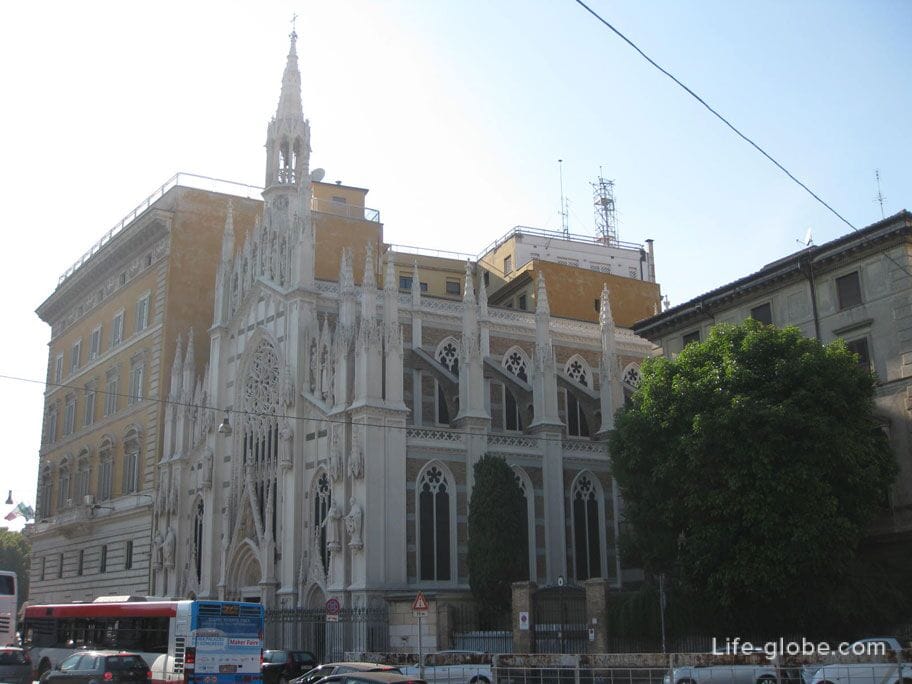
The Palace of justice and square Cover
The majestic, monumental and "bright" in the Supreme/High court (Corte Suprema di Cassazione) is undeniably one of the most outstanding buildings of Rome, and resembles a Palace, no wonder this building is also known as the Palace of Justice.
The justice Palace is the residence of court of Cassation of Italy and the Judicial Public library, located in the Prati neighbourhood on the banks of the river Tiber.
Made in the style of the late Renaissance and the Baroque building of the Palace of justice has a size of 170 to 155 meters and completely covered travertine limestone. The main facade of the building overlooks the Tiber river and crowned by a huge bronze Quadriga, installed in 1926. Ramps in front of the main entrance and courtyard is decorated with 10 large statues of prominent Italian lawyers.
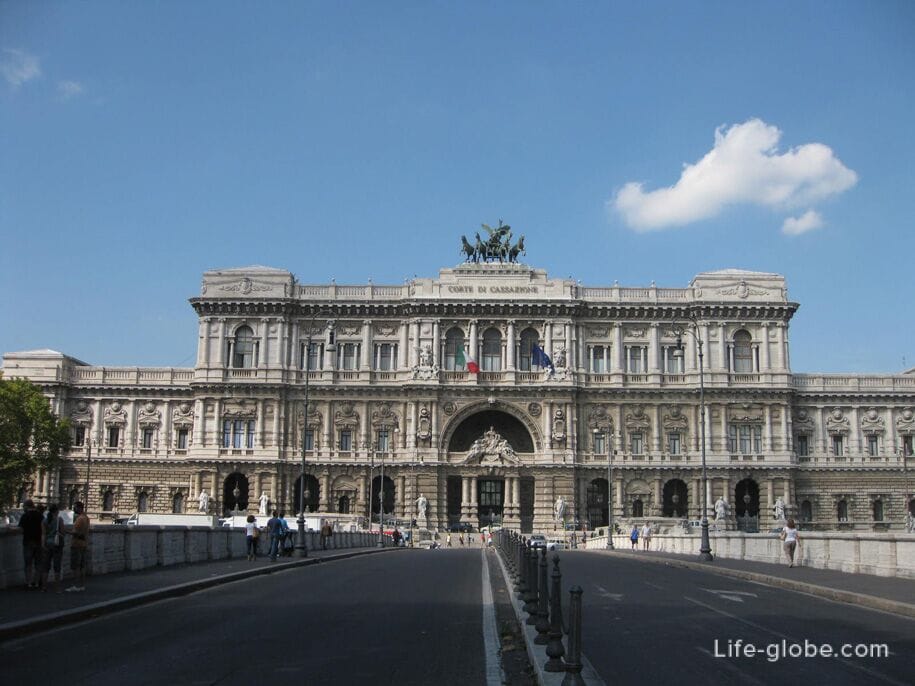
Courtyard of the Palace of justice stands a fine and well-kept area Cover (Piazza Cavour) at first glance attention-grabbing and haunting soul. The atmosphere of the square is different from all Ancient Rome. You seem like you are in the heart of history, surrounded by historical and architectural creations, and behind the Palace of justice, as if transported to another world - a more modern world of peace and harmony.
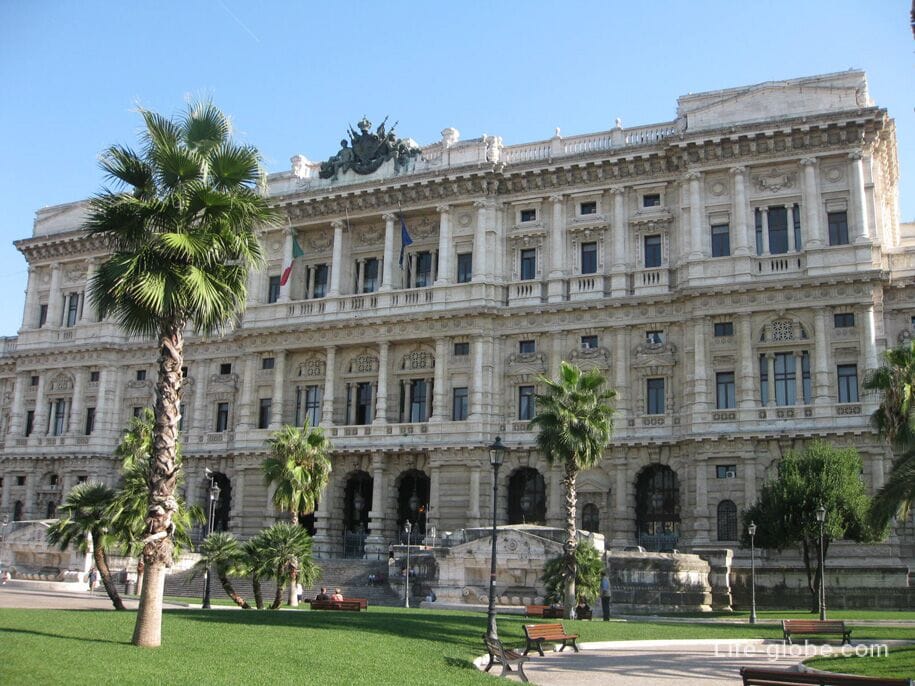


The Piazza Farnese and the fountains in the form of flowers Iris
Farnese square (Piazza Farnese) is a small square, executed in typical Roman style. Unlike other famous squares in Rome, Piazza Farnese is less well known. But that doesn't make the area less beautiful, on the contrary, in the absence of the tourist crowds can be more than enjoy the beauty of the area and Roman architecture.
The centre of the Piazza Farnese decorated with two, almost identical fountain (Fontane di piazza Farnese) installed at different times. Both the fountain Farnese was created from grey granite baths remaining from the once famous in Ancient Rome, the baths of Caracalla. Each fountain is crowned with a stone sculpture of the Iris flower. Why Iris? the fact that iris was a symbol of the family of Farnese, which was laid out square.
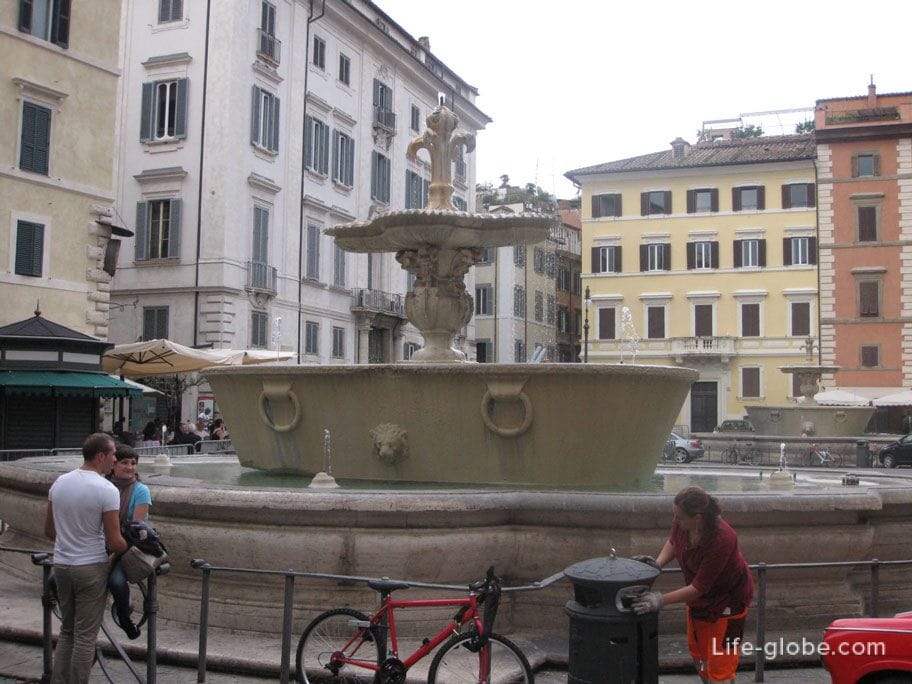
The main building of the square stands the Palazzo Farnese (Palazzo Farnese) is a Roman Palace, which is considered one of the best examples of the Renaissance style. The Palace, at first glance, the building is inconspicuous, however, is of great importance, being the most important and high in Rome a Renaissance Palace.
To the right of the Palazzo Farnese is a small Swedish Church Santa Brigida or St. Bridget (Chiesa di Santa Brigida). The Church dedicated to Saint Bridget of Sweden, who arrived in Rome in 1350 where she started a new order. In 1354 Bridget moved to a house at the Farnese square where she lived until her death in 1373. The facade of the Church is made in Baroque style, dates from the SEVENTEENTH century.

Piazza Della Minerva
Piazza della Minerva (Piazza della Minerva) is a square in the historical centre of Rome, located near the Pantheon in the Pigna district. The name of the square comes from the temple dedicated to the goddess of wisdom Minerva, built on the orders of Roman statesman and General gnaeus Pompey.
At such a small area are concentrated several interesting attractions. The main of which are:
Church of Santa Maria Sopra Minerva (Basilica di Santa Maria Sopra Minerva). Piazza della Minerva is very low in Rome, and often suffered from flooding when floods of the Tiber. To the right of the entrance to the Church, on the facade, there are signs showing the level reached by the Tiber during floods with 1422 1598 for years;
- in the centre of the square is decorated with the Obelisk of Minerva (Obelisco della Minerva), established in 1667, and having the shape of an elephant with an obelisk on his back.
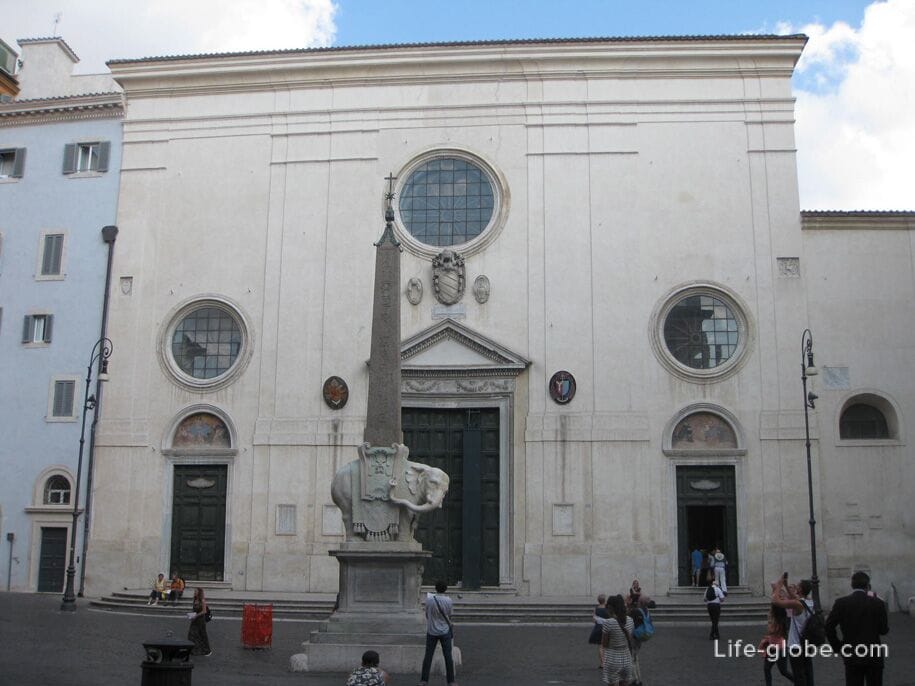
Theatre Of Marcellus
Theatre of Marcellus (Teatro Marcello) is an ancient theatre built in the I century BC, now represent an interesting historical landmark.
Once the theatre of Marcellus was one of four stone theatres could seat up to 15 thousand spectators and had three tiers. To this day partially preserved only the two lower tiers.
Sorry, currently theatre of Marcellus is not the main attraction of Rome, and many tourists pass by his side. In our opinion, a very good reason! The theatre is an interesting historical place, which, personally, we would be prirovnyat to the Colosseum and Roman Forum, and of course put on one of the first places in the list of sights of Rome. Is the theater of Marcellus near the Tiber island (Isola Tiberina) that the river Tiber.

Here you can see the amazing architecture of the Catholic Church of San Nicola in Carcere. Churches of this architecture in Rome, not so much.
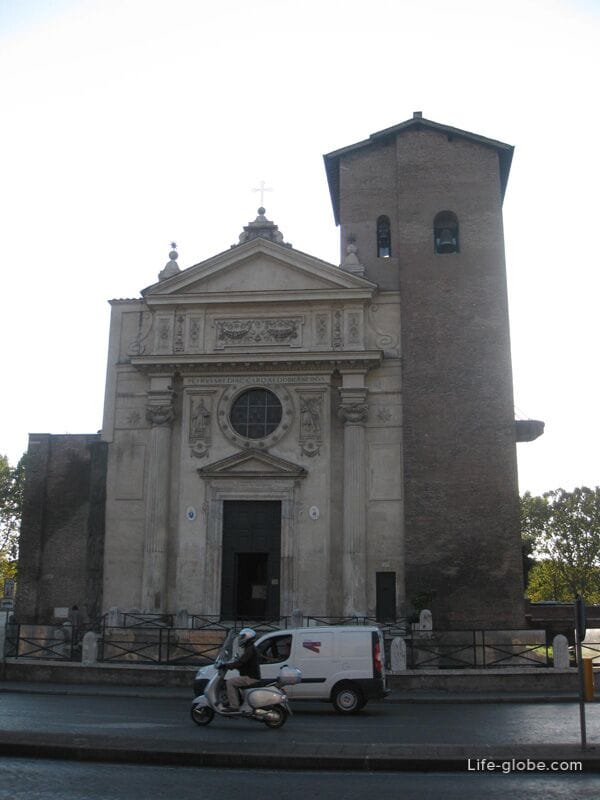
Column Of Marcus Aurelius
Column of Marcus Aurelius (Colonna di Marco Aurelio) is a majestic monument, the Doric column is located in Rome named after the square Column (Piazza Colonna). The column was erected in memory of Narkomankoy war of Marcus Aurelius. The prototype of the column of Marcus Aurelius was the column of Trajan.
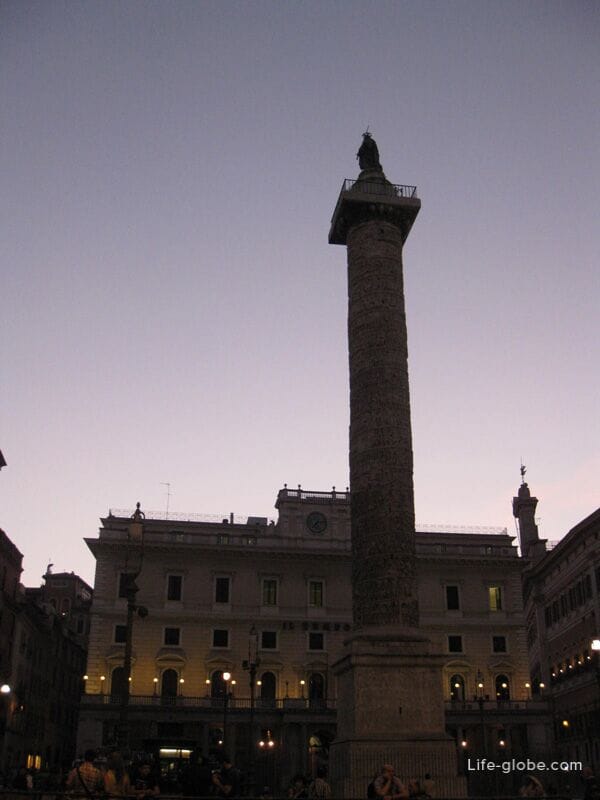
Basilica of Santa Maria in Cosmedin
Small Church - Basilica of Santa Maria in Cosmedin (Chiesa di S. Maria in Cosmedin) has a fairly unusual architecture, the main building is low, only 2-3 floor, but from afar, attracting the attention of a high tower.
However, not even this Church so appealing. The fact that there is a marble disk, depicting a bearded face with an open mouth. Marble drive is called the "Mouth of Truth" (Bocca della Verita). According to legend, anyone who put a hand into the open mouth image and to tell the truth, I bit the fingers or even whole hand, depending on how "dangerous" was a lie.
Near the Church, on the square there are: the Triton fountain (Fontaine des Tritons), Beef Forum (Foro Boario), the Temple of Hercules (Tempio di Ercole Vincitore) and Portuna Temple (Tempio di Portuno).
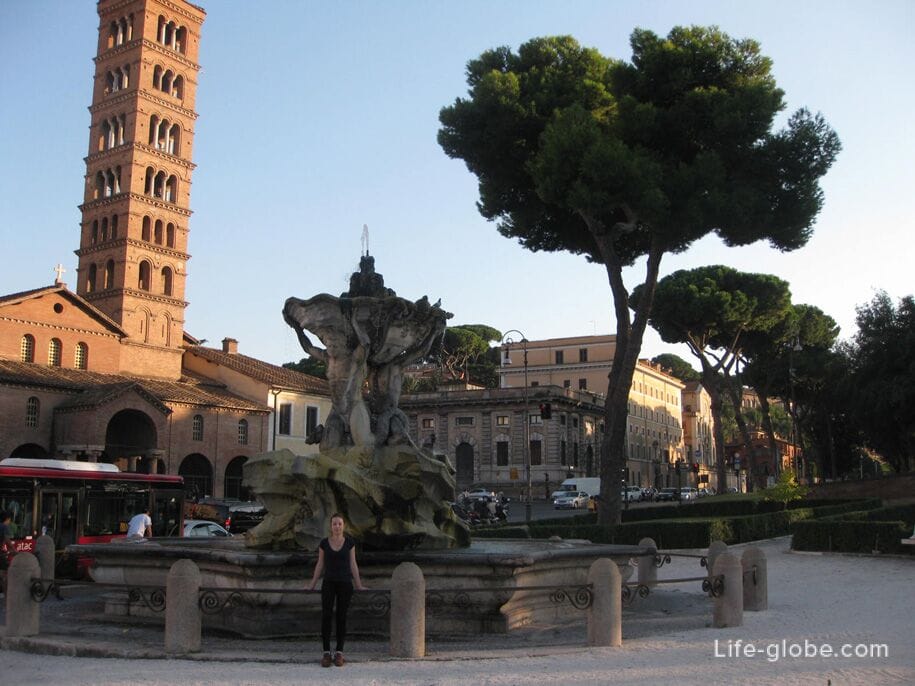

The historic center of Rome, convenient to walk to. So you can fully enjoy the grandeur and beauty of the city, besides, all the main sights of the old part of Rome concentrated "handful", a walking distance from each other. For this reason, when choosing where to stay in Rome, we can safely recommend to book hotels in the historic centre. Yes! The hotel room in the centre will cost a bit more expensive than on the outskirts of the city. But! Trying to save money on a hotel, in this case we save. Daily route from the hotel to the center and back will take time, besides it is a waste of effort and money on the road itself. But to walk and explore Rome by day, Rome is a nice stroll in the evening (after dark), at this time the city plays with new colors, what day do not see it.
What to see in Rome in 1 -2 day -3
Naturally, one or even three days for Rome is very small, we need at least a week or two. However, to examine the basis is still possible. Hard to say what you can manage to visit in Rome for 1 -2 or 3 days, in such matters everything is very individual and depends on the tastes and personal preferences, someone is going just for the sake of the Vatican and some of the most famous squares, while others want to explore every nook and cranny. The itinerary also depends on how you travel (by foot, car or public transport) how much it will be to start and end your day, how much time during the day you will be out to visit cafes and restaurants, will this go to museums and parks, etc.
Despite this, some General information can lead
1 day
The center, which can be explored on foot and where all the main sights will be focused next.
If you have only one day: the Vatican, Castel Sant'angelo, the Bridges, Piazza Navona, the Pantheon, Piazza Venezia, the Forum of Trajan, Colosseum + Roman Forum + arch Constatine, in the evening (at sunset) the Trevi fountain.
The day will be very busy and active, so 1 day to go to Rome, we believe, does not make sense.
If you have at least three days, the first day you can devote to more detailed and thorough inspection of the center: Piazza Venezia + Capitoline hill, the Forum of Trajan, Colosseum + Roman Forum (Palatine) + arch of Constantine, Circus Maximus.
2 days
Plus to the first day: the Vatican, Castel Sant'angelo, the bridges, the theatre of Marcellus + Tiberina island, Piazza Navona, Pantheon.
If you only have two days, then here you can add: Plaza de españa, Plaza Popolo + Pincio gardens and Trevi fountain, as well as all what you see along the way.
3 days
Third day: Spanish steps, Popolo square + gardens of the Pincio, Trevi fountain, the Museum of souls in Purgatory, in the remaining time, everything else, personal taste and discretion. And you can just go to the sea.
Ideally, of course, it is better to make the route independently, based only on their preferences.





